


The Return of the Sounds of Yesteryear
Recycled Floyd material: A track-by-track analysis
Recycling, reinventing, revisiting, or using music, themes, ideas, or arrangements as a basis for further development: what could easily be perceived as repetition and lack of originality, in the hands of Floyd became a skill that (nearly always) managed to yield creative and interesting results.
What follows is an attempt to list such 'recurring' ideas in Pink Floyd's catalogue, in the form of a track-by-track guide, ranging from the obvious to the obscure. Omissions are inevitable in a task like this, yet the following analysis hopefully makes for an interesting overview of the band's development through the years. In roughly chronological order we shall examine the band's creative saga, starting with their early, highly prolific, period and work our way towards the 1990s and the band's most recent output. Although the arrangement of the sections is linear, the cross-influences between songs go back and forth in time, so keep in mind that if you skip a section you are likely to miss out the era of your choice. Enjoy!
• • •
Part 1 - from
"Interstellar Overdrive"
to Ummagumma
(1967 - 1969)
• • •
"Interstellar Overdrive" (1967) bass
![]() "Let There Be More Light" (1968) bass line behind main verses
"Let There Be More Light" (1968) bass line behind main verses
Floyd's first-ever 'proper', sound-defining instrumental jam contained many fragments of ideas they would later explore, revisit, or stretch. A prominent bass riff heard among the chaos of "Interstellar Overdrive" resurfaced as a proper bass line in the Roger-penned "Let There Be More Light" a year later. The bass line in question is heard behind the "far..far..fa..far away ..way.. people heard him say.. say" verses.
• • •
"Interstellar Overdrive" (1967) bass line #2
![]() "The Labyrinths of Auximines" (1969) bass line
"The Labyrinths of Auximines" (1969) bass line
![]() "Corrosion" / "Moonhead" (1969) bass line
"Corrosion" / "Moonhead" (1969) bass line
![]() "Money" (1973) bass in the 4/4 middle section
"Money" (1973) bass in the 4/4 middle section
The Bo Diddley-like bass line of "Moonhead" (e.g. live 10 July 1969) was used by
Roger in several transitional compositions ("Corrosion", "The Labyrinths Of Auximines",
and during live instrumental jams of other tunes) between 1968-70. It eventually
appeared again in the middle section of "Money" where the time signature
changes back to 4/4 and the guitar 'shrinks' and goes completely dry. A nucleus
of this was first
worked out in "Interstellar Overdrive".
• • •
"See Emily Play" (1967) vocal melody
![]() "Shine On You
Crazy Diamond" part 9 (1975) synth phrases
"Shine On You
Crazy Diamond" part 9 (1975) synth phrases
The final Minimoog synth phrases played by Rick in the coda of "Shine On
You Crazy Diamond" (part 9) were
recycled melodies from the Syd-penned single "See Emily Play". This was
on purpose, as a tribute to Syd, whom "Shine On" is
largely about. There are, allegedly, other snippets of Syd melodies played by
Rick during that coda, but the "See Emily Play"-inspired one ("Emily
tries... but misunderstands...aaa..aaaa") is by far the most prominent,
whereas the others are somewhat obscure.
• • •
"Astronomy Domine" (1967) Morse code
sound effects intro
![]() Radio K.A.O.S. (1987)
Morse code sound effects - opening & closing
Radio K.A.O.S. (1987)
Morse code sound effects - opening & closing
Barrett's "Astronomy Domine" starts with Morse-code sound effects, an idea
borrowed by Waters twenty years later for the opening and closing of his
Radio K.A.O.S. (1987) concept album.
• • •
"Pow R Toc H" (1967) opening & closing screams
![]() "Careful With
That Axe, Eugene" (1968) scream
"Careful With
That Axe, Eugene" (1968) scream
![]() "The Embryo" (live 1970-71) screams
"The Embryo" (live 1970-71) screams
![]() "Pigs (three
different ones)" (live 1977) screams
"Pigs (three
different ones)" (live 1977) screams
![]() "The Happiest
Days Of Our Lives" (1979) coda scream
"The Happiest
Days Of Our Lives" (1979) coda scream
![]() "Run Like Hell"
(1979 / live 1980-81) screams
"Run Like Hell"
(1979 / live 1980-81) screams
![]() "Two Suns In The
Sunset" (1983) scream in 1st chorus
"Two Suns In The
Sunset" (1983) scream in 1st chorus
Roger's screams (often fortified with ample echo and panned around the audience
to chilling effect) became staples of Floyd's live performances. It would be easy to
neglect that it all began with the opening 'voicings' of "Pow R Toc H" from Piper
at the Gates of Dawn. Of course Roger would refine his screaming technique
further, making it a stand-out moment in "Careful With That Axe, Eugene" (1968),
in the classic build-up that reaches its crescendo with the
powerful scream. Apart from "Eugene", Roger often
screamed and shouted during other early numbers, like "The Embryo"
(live 1970-71). He was set to screaming
mode again in his final two tours with Floyd: he would scream with heavy
echo and a 'metallic' flanger/phasing effect throughout the live '77 renditions
of "Pigs" (e.g. the famous final gig in Montreal, 6 July 1977) and he would
later do the same in the live 1980-81 renditions of "Run Like Hell".
Short, chilling screams were also a defining element of the moody atmosphere of The Wall (1979)
and were featured in "The Happiest Days of Our Lives"
coda, in several parts of Music From The Film (1982) and in Floyd's last
song to feature Roger Waters, "Two Suns In
The Sunset" from The Final Cut (1983) after the line "you stretch
the frozen moments with your fear"
.
• • •
Games For May (live 1967) taped bird
effects
![]() "Cirrus Minor" (1969) bird tapes
"Cirrus Minor" (1969) bird tapes
![]() "Several Species
Of Small Furry Animals..." (1969) bird tape effects
"Several Species
Of Small Furry Animals..." (1969) bird tape effects
![]() "Grantchester
Meadows" (1969) bird tape effects / (live 1970)
bird tapes
"Grantchester
Meadows" (1969) bird tape effects / (live 1970)
bird tapes
![]() Bird soundscapes (live 1970-71) bird tapes
Bird soundscapes (live 1970-71) bird tapes
![]() "Goodbye Blue
Sky" (1979) bird intro
"Goodbye Blue
Sky" (1979) bird intro
![]() "Late Home
Tonight, Part I" (1992) bird intro
"Late Home
Tonight, Part I" (1992) bird intro
![]() "What God Wants,
Part III" (1992) locust & cricket sounds
"What God Wants,
Part III" (1992) locust & cricket sounds
The late '60s saw many pop artists experimenting with tape recorders and
effects that touched on musique concrète (a
big Floyd chapter in its own right) and avant-garde, following the way paved by
Stockhausen, John Cage, and other 'serious' musicians before them. Lennon and McCartney
did it (e.g. effects from Revolver, Sgt Pepper's and, of course, "Revolution
9"), and Eno and Fripp also experimented with tape recorders later, before the
advent of commercially available synthesizers. Obviously, Floyd could not have
been missing from this list; Waters started experimenting with a Ferrograph tape
recorder as
early as 1967. As part of Games For May (performed live in Queen Elizabeth
Hall, 12 May 1967) he made "bird" noises recorded at half-speed, to be played in
the theatre's foyer as the audience was coming in. The idea of providing taped
soundscapes for the audience is a concept that has followed Floyd ever since.
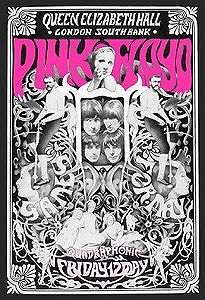 Games For May |
The idea of the 'bird tape effects' (that are not real birds but noises or voices sped up) was used again in "Grantchester Meadows" (1969) and "Several Species of Small Furry Animals Gathered Together in a Cave and Grooving With a Pict" (1969). The latter, in particular, featured tape-manipulated noises that were orchestrated like a mini animal symphony.
On the subject of 'bird' sounds, specifically, Floyd used a tape of singing birds from the EMI Sound Library in "Cirrus Minor". Certain live versions of "Grantchester Meadows" also featured the very same bird tape (e.g. the renditions performed in California, 29 April 1970). Moreover, tapes of bird sounds frequently opened 1970-71 concerts (e.g. Copenhagen, 25 September 1971) as ambient soundscapes before the band segued with tracks like "Careful With That Axe, Eugene" or "Cymbaline".
• • •
Games For May (live 1967) cymbal tape
effects
![]() "A Saucerful Of Secrets" (1968) cymbal/gong intro
"A Saucerful Of Secrets" (1968) cymbal/gong intro
"Quicksilver" (1969) tape effect intro
"Several Species..." (1969) tape effects
"Sysyphus part 3" (1969) tape effects
"The Narrow Way part 2" (1969) tape effects
"The Grand Vizier's Garden Party part 2" (1969) percussion
tape effects
Music From The Body (1970) tape effects
As part of his experimentation with tapes in 1967, Roger also recorded "edge tones off cymbals" for the Games For May performance, sitting in "a dark, dingy basement off Harrow Road, with an old Ferrograph". That segment, featuring cymbals recorded at various speeds, was later used as the beginning of "A Saucerful Of Secrets". Similarly, the intro of "Quicksilver" features the recording of what sounds like a metallic object strumming the strings of a grand piano, recorded and then sped up and down. "Several Species...", as has already been mentioned, featured many recorded noises (including a backwards message--see separate entry) manipulated in a way that resembles animal-like noises.
Tape manipulation and use of the Mellotron (which was also tape-operated) reached, in Ummagumma, a degree of sophistication unparalleled at the time, in an era where digital sampling was light years away. Ron Geesin taught Waters and Mason quite a lot about tape editing and manipulation. Geesin's and Waters' tape treatment skills reached a peak in their Music From The Body (1970) where the complexity of some of the instrumental passages (written by Geesin) even surpassed that of "Several Species...".
The studio version of "A Saucerful Of Secrets", "Sysyphus part 3" and "Narrow Way part 2" also make use of tape sound collages amidst the other sounds and effects used. And of course Mason's "Grand Vizier's Garden Party, part 2" consists almost entirely of such tape-manipulated recordings of percussion and cymbals.
• • •
(More Furious Madness from) The Massed Gadgets Of Auximines (live 1969)
tapes
Zabriskie Point (1970) tapes
Atom Heart Mother (1970) tapes
The Dark Side Of The Moon (1973) tapes
Wish
You Were Here (1975) tapes
Animals (1977) tapes
The Wall (1979) tapes
The Wall - Music From The Film (1982) tapes
The Final
Cut (1983) tapes
The Pros And Cons Of Hitch-Hiking (1984) tapes
When The Wind Blows (1986) tapes
Radio K.A.O.S. (1987) samples
A Momentary Lapse Of Reason (1987) samples
Amused To Death (1992) samples
The Division Bell (1994) samples
Broken China (1996) samples
Floyd continued to use tape effects on every major release, not by manipulating tapes in an attempt to achieve 'sound-mangling' results anymore, but rather by using recorded sounds, noises, and dialogue interspersed in the music, as if it were an extra instrument. The Man & The Journey (live 1969) concerts featured many such tapes; "Heart Beat, Pig Meat" from Zabriskie Point (1970) was a tape collage. Atom Heart Mother (1970) featured taped recordings in abundance (horses, trains, bells, 'breakfast' sounds) and the original vinyl pressings had the dripping tap effect that closes the album set into an infinite 'loop' by making the vinyl run-out groove interminable so that listeners had to manually stop the turntable in order for the water to stop dripping! Meddle (1971) and Obscured by Clouds (1972) do not feature them quite as much (with the exception of the taped extract of "You'll Never Walk Alone" and the chant at the end of "Absolutely Curtains"), but tape effects made a spectacular return in Dark Side Of The Moon (1973) and are a feature of every album since. The use of the cash register/coin effect as a 'loop', in "Money", was quite innovative for its time, and the clocks and voices heard during the album were among the album's most memorable elements. Wish You Were Here (1975), with its laughs, crowd, radio, and wind noises, and Animals (1977), with its animal noises, contain their fair share of tapes, but the phase between The Wall (1979) and The Final Cut (1983) sees an apotheosis of musique concrète that would keep being a focal point of all subsequent solo efforts by Waters. 1987 marks the point when Floyd and Waters camps adopted digital sampling and the credit "tape effects" becomes a euphemism thereafter, because such recorded snippets were stored and recalled as digital samples, both live and in the studio. The principle, however, is exactly the same; only the means is different. The use of specific sound effects that have appeared on more than one occasion in Floyd's canon is further discussed in this article.
• • •
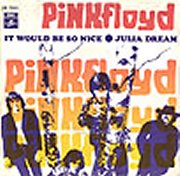 The cover of "It Would Be So Nice/Julia Dream" single (1968). |
"Julia Dream" (1968) guitar soundscapes in
coda
"Interstellar Overdrive" (live 1968-70) slide guitar soundscapes
"Sleeping" (1969) guitar soundscapes
"A Saucerful Of Secrets: Syncopated Pandemonium
/ Storm Signal" (live 1969-71) slide guitar
soundscapes
"The Narrow Way" parts 1 & 2 (1969) guitar soundscapes
...etc.
Gilmour had a knack for creating weird and wild soundscapes by experimenting with slide guitar (where the 'slide' would often involve abusing mikestands and lighters), heavy delay/reverb/other effects, and plugging cables the wrong way from/to his amps and effect units. The psychedelic soundscapes he produced--particularly live--up until the Atom Heart Mother / Meddle era (he evidently grew tired of it all from that point onwards) were paramount to Floyd's 'space/psychedelic/far-out' image and dominated the band's long instrumental passages as much as Wright's keyboard layers and treatments. The above list is not meant to be complete, but it rather serves as a reminder that the often neglected "Julia Dream" single offered young Dave his first opportunity to put his guitar experimentation to practice (the track was recorded in 13 February 1968 and was released as a single B-side before A Saucerful of Secrets) and, let's not forget, his first lead vocal with the Floyd too. In it, we also hear Rick using a Mellotron for the first time, but we shall examine that in more detail later on. Gilmour's guitar frenzy reached a peak in his noise explorations during live performances of "Interstellar Overdrive" and "A Saucerful Of Secrets", particularly during the "Syncopated Pandemonium" and "Storm Signal" parts.
'Controlled guitar chaos' was also evident (helped by some generous tape splicing in the studio) in the recordings of "The Narrow Way" (1969) parts 1 and 2. Dissecting every sound source from this Ummagumma recording is a real challenge, and has caused considerable debate as to whether Dave was merely using guitars, amps, effects, mellotron, and perhaps tape manipulation techniques, or whether he had brief access to Abbey Road Studios' Room 43, where The Beatles had their big Moog IIIc modular synthesizer. Ummagumma was recorded and mixed in Abbey Road Studio 2, during the same period Beatles recorded and mixed Abbey Road (1969) in the very same studio. The Fab Four had their Moog synthesizer locked in Room 43, feeding its signal to the Studio 2 control room. Alan Parsons, who would go on to engineer Atom Heart Mother for the Floyd a few months later, was the engineer for Beatles' Abbey Road sessions, so it is not extremely far-fetched that Gilmour may have twisted on Alan Parsons' arm to feed his guitar through the mighty Moog synth. This is pure speculation, though, and if my theory is wrong then all we are left with is that Gilmour produced these sounds with his guitar and the humble Binson Echorec units, which was quite a feat for a 1969 recording!
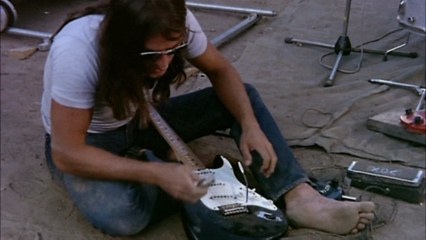 Let's see how this will sound now that my Vox pedal
is plugged the wrong way 'round. |
• • •
"Let There Be More Light" (1968) bass intro
![]() "Main Theme from
More" (1969) bass line
"Main Theme from
More" (1969) bass line
![]() "Dramatic Theme" (1969) bass line
"Dramatic Theme" (1969) bass line
The oft-imitated (Placebo's "Taste in Men", anyone?) bass line that opens "Let
There Be More Light" formed the basis of two theme variations that surfaced in
the More soundtrack (1969). "Dramatic Theme" is the most obvious, and the
"Main
Theme from More" is also held by the same line.
• • •
"Let There Be More Light" (1968) chorus
vocal melody
"Point Me At The Sky" (1968) chorus vocal melody
The melody behind the chorus of "Let There Be More Light", sung by Gilmour:
"..then at last the mighty ship, descending on a
point of flame
made contact with the human race at Mildenhall"
is quite similar to the melody behind the chorus vocals handled by Waters in "Point Me At The Sky":
"..pointing to his cosmic flier, pull his plastic
glider higher
Light the fuse and stand well back, he cried 'This is my last goodbye'."
Incidentally, the Beatles-esque "Point Me At The Sky" is often referred to as Waters' tune, but it was in fact the very first Waters/Gilmour composition.
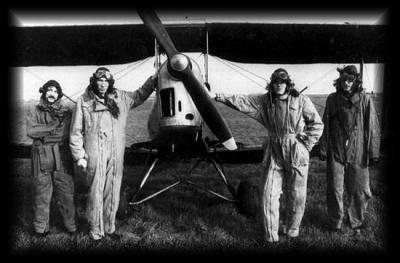 Floyd getting ready to be pointed at the sky (1968) |
• • •
"Set The Controls For The Heart Of The Sun"
(1968) seagull sounds
"Seabirds" (1969) seagull sounds
"Southampton Dock" (1983) seagull sounds
Discussing similarities in the use of 'sound effects' is bound to be a stretch.
However, there are certain themes that are more recurring than others, and it is
these themes that are listed here. Bird sounds have already been discussed, but this
time it is the seagulls' turn. Distinct from Gilmour's seagull-like guitar wails
(which are a different thing altogether), tapes of seagull noises were first used in
"Set The Controls For The Heart Of The Sun" (1968) and in "Seabirds" (outtake from More - 1969). They
made a reappearance 14 years later, in "Southampton Dock" (1983)--docks tend to
have seagulls, after all.
• • •
"One In A Million" (1968)
![]() "Cirrus Minor" (1969)
"Cirrus Minor" (1969)
"Grantchester Meadows" (1969)
"Goodbye Blue Sky" (1979)
The unreleased Syd-era "One In A Million" may not exactly fit the 'pastoral/acoustic'
motif, but its guitar riff was used by Roger in "Cirrus Minor" (albeit at a
different tempo). "One In A Million" notwithstanding, the other three
Waters-penned acoustic tunes ("Cirrus Minor", "Grantchester Meadows", "Goodbye
Blue Sky") have more than a few points in common:
:: They all have bird/'nature' sounds in their intro (as discussed in a
separate section above);
:: They have very similar acoustic guitar riffs/verse structure;
:: The structure similarities even extend to the tracks' arrangement.
Let's not forget that both "Grantchester Meadows" and "Goodbye Blue Sky"
featured very similar keyboard codas by Rick when performed live (e.g. "Grantchester Meadows" live 1969-70 and
"Goodbye Blue Sky" live 1980-81)
• • •
"Cirrus Minor" (1969) organ coda
![]() "Waves" (1978)
organ coda
"Waves" (1978)
organ coda
The organ outro of Rick's stand-out track "Waves" from his 1978 solo album Wet Dream owes
much to the organ and bass-based outro of Floyd's "Cirrus Minor" (1969).
• • •
"A Saucerful Of Secrets: Syncopated Pandemonium"
(live 1969) drums, piano & organ
![]() "Up The Khyber" (1969) drums, piano & organ
"Up The Khyber" (1969) drums, piano & organ
"Up The Khyber", the brief Wright / Mason ditty from More is quite similar to Rick's and Nick's
respective parts during the "Syncopated Pandemonium" section of "A Saucerful Of
Secrets". Add Gilmour's guitar and Waters' gong & bass and you nearly have the
live 1969 version from Ummagumma.
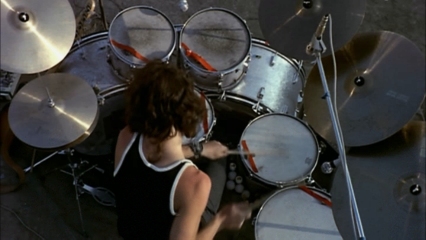 Mason flexing his muscles in Pompeii (1971) during "Syncopated Pandemonium" |
• • •
"The Committee - Theme #9" (1968) bass
octave
![]() "Murderistic Woman" (1968) bass octave
"Murderistic Woman" (1968) bass octave
![]() "Careful With
That Axe, Eugene" (1968) bass octave
"Careful With
That Axe, Eugene" (1968) bass octave
![]()
![]() "Beset By Creatures
Of The Deep" (live 1969) bass octave
"Beset By Creatures
Of The Deep" (live 1969) bass octave
![]()
![]() "Come In No 51,
Your Time Is Up" (1969-70) bass octave
"Come In No 51,
Your Time Is Up" (1969-70) bass octave
"Sheep" (1977) bass octaves in the middle section
"Goodbye Cruel World" (1979) bass octaves
"It's A Miracle" (live 1999-2000) bass octave
The origins of "Careful With That Axe, Eugene" can be traced back to the (as yet
officially unreleased) soundtrack of The Committee. As there are no known
official titles for the tracks that are featured in the film, the title "Theme
#9" is given here as an indication of the relative position of the song. It is a
very brief segment that contains Roger's characteristic bass
octave-playing and Rick's Farfisa organ soloing. This particular idea was
developed a bit further in "Murderistic Woman", the working title for what would
become "Careful With That Axe, Eugene" (1968), a study on dynamics that
exercised building up tension on top of one single chord. "Careful..." would be
performed in various incarnations, like "Beset By Creatures Of The Deep" (1969)
in The Man & The Journey
live suite.
Floyd would re-record and rename the track as "Come In Number 51, Your Time Is Up"
(1970) for Antonioni's Zabriskie Point soundtrack, and would often
introduce it under different names in live performances.
What sets the track off is the repetitive bass octaves played by Roger. Apart
from "Careful With That Axe..." incarnations, Roger often
added his octave patterns to other tunes (for example during "Sheep" from 3'56"
until 5'26"), the most recent one being the live
rendition of his solo piece "It's A Miracle", which musically owes much to
"Careful..." anyway (for the record, the bass on that track in the 1999-2001 live shows was
actually played by Andy Fairweather-Low).
The above list is by no means complete. The list of songs where Roger plays his
trademark octaves is even longer than the one where Gilmour adds the Dr. Who
snippet. Absurdly simplistic as it may be, there is something quite
compelling about it. Roger's tendency to stick at octaves has frequently been
the cause of mocking his playing technique, yet I would urge the reader to think
of any other bass player who has managed to pull this off as tastefully as
Roger throughout his career. It all comes down to the doctrine that seems to
apply to all four members: 'simplicity is elegance without effort'. The things
associated with Floyd's music that have been the most evocative are often the
simplest and less-complicated melodic ideas of all. And this is part of what
constitutes the chemistry between them.
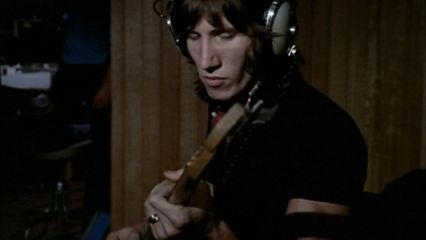 What shall I play now? Ah, forget it, I'll just stick
to my octaves. |
• • •
"Careful With That Axe, Eugene" (1968) scat
singing
"Green Is The Colour" (live 1970-71) scat during guitar solo
"Heart Beat, Pig Meat" (1970) a cappella falsetto vocal
"Cymbaline" (live 1971) scat during guitar solo
"Any Colour You Like" (1972-73) scat during guitar solo
"Wish You Were Here" (1975) scat during acoustic solo
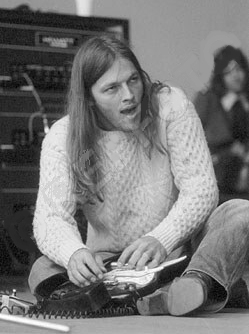 He's not yawning, he's scat-singing! Gilmour in Crystal Palace (1971) doing his scat bit. |
Dave's 'scat' singing (the falsetto vocal that, quite remarkably, echoes the
melody Dave is playing with his guitar) has been a feature of many tunes. It is
prominent in "Careful With That Axe, Eugene", as is in "Any Colour You Like"
(1973)--the working title of which was actually "Scat"--and "Wish You Were Here"
(1975). In
all three tracks it plays an important role and complements Dave's guitar
playing.
In the early days, Gilmour would often get carried away, scat-singing in other tracks too, like,
for instance, in live renditions of "Green Is The Colour" (e.g. live 16 July
1970) and "Cymbaline".
"Heart Beat, Pig Meat" features Dave's falsetto singing 'a cappella', without
any guitar accompaniment, in the same vein as the early live versions of "The
Amazing Pudding"/"Atom Heart Mother" (1970) when Dave and Rick
handled the high-pitched
vocals of the 'choir' section (with the help of a little echo to 'smooth the
edges').
• • •
:: (More Furious Madness From) The Massed Gadgets Of Auximines
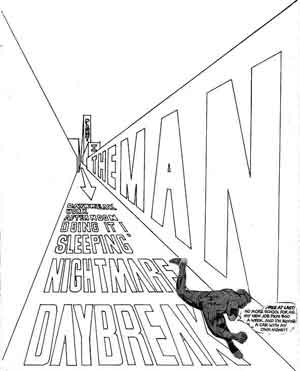 "The Man" - page from the 1969 concert programme |
The Man & The Journey (live 1969):
Under the collective title The Massed Gadgets Of Auximines (or, if you
prefer, More Furious Madness From The Massed Gadgets Of Auximines), Floyd Mk II presented for
the first time (second, if you count the Syd-era Games For May) a series of
pieces as a unified whole--a 'concept': The Man & The Journey. The majority of it was based on existing material,
reworked and re-titled. Most tracks were merely renditions of renamed songs that
had been released already or were to be released soon after; while some of them
were based on melodic passages of existing tunes that were not as obvious. The
following list analyses the origins of each song in these two suites: The Man
and The Journey:
"Daybreak" (live 1969)
"Grantchester Meadows" (1969)
A pretty straightforward rendition of the track. The difference between the
studio and live versions is that both Waters and Gilmour shared acoustic guitar
and vocal duties. Waters sang the main verses, while Gilmour beautifully handled
the more melodic chorus verses.
• • •
"Biding My Time" (1969)
"Work"/"Afternoon" (live 1969)
![]() "More
Blues" (1969)
"More
Blues" (1969)
![]() "Love Scene
version 6" (1970)
"Love Scene
version 6" (1970)
![]() "(Pink) Blues"/"Just Another 12-bar" (live 1970-71 & live
1977)
"(Pink) Blues"/"Just Another 12-bar" (live 1970-71 & live
1977)
The studio version of "Biding My Time" (recorded in July 1969) was only released officially as part of
the Relics compilation (1971). The live renditions heard earlier in
The Man suite were significant for the fact that Rick could be seen
playing the trombone live, during the 12-bar section.
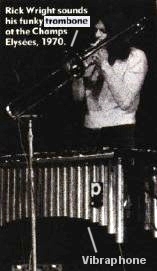 Wright playing the trombone in Champs Elysées (1970) during 'Work/Afternoon'. In front of him, his vibraphone. |
Besides the fact that a lot of Floyd's music is rooted in the blues (during 1965 the band even called themselves "The Pink Floyd Blues Band"), the band did occasionally perform 'standard' blues jams on stage. "Biding My Time" definitely had more of a standard 'bluesy' feel than other tunes until that point. Its coda was a 12-bar they would revert to quite a lot in their career. "More Blues" from More (1969) as well as live instrumental jams known on bootlegs as "Blues", "Pink Blues" or "Just Another 12-Bar" frequently featured in their live set circa 1970-72. They even recorded one such number for Zabriskie Point (it was released in the double-CD reissue) under the name "Love Scene Version 6".
As Floyd's popularity grew, post-Dark Side, their concerts became increasingly more structured and less 'impromptu' than before. Besides, by the mid-seventies they already had a significant amount of existing material to choose from, so they rarely performed these blues numbers anymore. One notable exception occurred in the infamous last concert in Montreal, 6 July 1977, where the band (sans Gilmour, who had stepped down by that point) performed a blues encore "to go home to", while the roadies were dismantling their equipment on stage. An unusual ending for an unhappy tour. The Gilmour-led Floyd also often performed throw-away blues jams in post-gig parties during their mammoth 1987-89 tour.
• • •
"Doing It!" (live 1969)
"The Grand Vizier's Garden Party part 2" (1969) drum pattern
A brief drum work-out that features one of the more memorable drum patterns of Nick's
piece from Ummagumma: "Part 2 - Entertainment".
• • •
"Quicksilver" (1969)
"Oenone" (1969)
"Sleeping" (live 1969)
![]() "Don't Leave Me
Now" (1979) breathing noises
"Don't Leave Me
Now" (1979) breathing noises
"Sleeping" was an instrumental featuring vibraphone (played by Wright), organ, and guitar,
with a feel similar to "Quicksilver". Between 1969-70, Floyd
recorded several variations of such long, dreamy, atmospheric instrumentals
based on organs and soundscapes. An unreleased outtake from the Zabriskie
Point sessions (dubbed by bootleggers as "Oenone") also followed that pattern.
The band also played tapes of heavy breathing noises; an idea that they would recycle ten years later, in "Don't Leave Me Now" (1979), from The Wall.
• • •
"Cymbaline" (1969)
"Nightmare" (live 1969)
"Nightmare" was a straightforward rendition of "Cymbaline" from Music
from the film More (1969). When
performed live, the track would include an extended 'footstep sequence' (in
glorious quadraphonic sound) that was meant to represent the nightmarish idea of
someone getting lost in what seems to be a house of many (locked) doors. The
combination of heavy breathing & footsteps was later revisited by Dark
Side engineer Alan Parsons
and assistant Peter James, in "On The Run" (1973).
 Part II - "The Journey" (page from the 1969 programme) |
"Green Is The Colour" (1969)
"The Beginning" (live 1969)
"The Beginning" was the opening number of the second suite of the show: a
straightforward rendition of "Green Is The Colour" where Gilmour replaced the
'piccolo' section by a guitar & scat solo (see above). "Green Is The Colour" seamlessly segued into a rendition
of "Careful With That Axe, Eugene" (see next). Floyd would often perform these
two songs together during 1970-71.
• • •
"Careful With That Axe, Eugene" (1968)
"Beset By Creatures Of The Deep" (live 1969)
"Beset By Creatures Of The Deep" was yet another name for "Careful with that
axe, Eugene".
• • •
"The Narrow Way" (live 1969)
"The Narrow Way part 3" (1969)
A very close rendition of what would become Part 3 of Gilmour's "Narrow Way" in
Ummagumma--only with vocals that were decidedly louder! (e.g. Amsterdam, 17
September 1969).
• • •
"Pow R Toc H" (1967)
![]() "The Pink
Jungle" (live 1969)
"The Pink
Jungle" (live 1969)
The "Pink Jungle" was a rendition of "Pow R Toc H" with slightly different, less
piano-driven, arrangement.
• • •
"Interstellar Overdrive" (1967)
![]() "The Labyrinths Of Auximines" (live 1969)
"The Labyrinths Of Auximines" (live 1969)
"The Labyrinths of Auximines" (the spelling of which varies between "Auximenes"
and "Auximines") was based on a bass riff contained in
"Interstellar Overdrive", also used in "Moonhead" and the middle
section of "Money" (see above).
• • •
"Behold The Temple Of Light" (live 1969)
"The Narrow Way part 2" (1969) coda
"Behold The Temple Of Light" was an instrumental passage with guitar (and gong), that was
based on the final guitar chord progression heard at the very (quiet) end of
"The Narrow Way part 2" (right before Dave starts singing the verses of "part
3").
• • •
"A Saucerful Of Secrets: Celestial Voices"
(1968)
![]() "The End Of The
Beginning" (live 1969)
"The End Of The
Beginning" (live 1969)
"The End Of The Beginning" was comprised of the "Celestial Voices" part of "A Saucerful
Of Secrets". Wherever it was available in the hall/venue, Rick opted to play this
piece on a proper church/pipe organ.
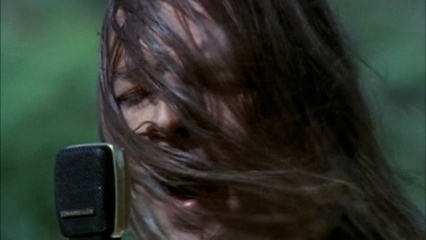 Dave singing his "Celestial Voices" part for Pompeii (1971). Note that his 'Live at Pompeii' performance in that section was overdubbed in the studio. |
• • •
"The Nile Song" (1969)
"Ibiza Bar" (1969)
![]() "Young
Lust" (1979)
"Young
Lust" (1979)
"The Committee - Main Theme Reprise" (1968) chord progression
![]() "Ibiza Bar" (1969) chorus
"Ibiza Bar" (1969) chorus
![]()
![]() "The Narrow Way
part 3" (1969)
chorus
"The Narrow Way
part 3" (1969)
chorus
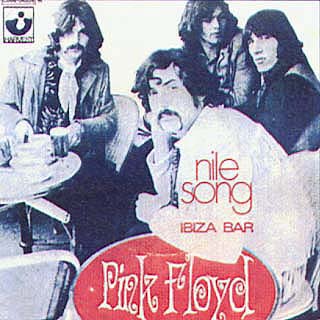 The cover of the "Nile Song/Ibiza Bar" single. |
The connection between "The Nile Song" and "Ibiza Bar" becomes immediately obvious: identical music and arrangement, with the sole exception of the chorus that features a double-tracked Gilmour falsetto vocal that is quite reminiscent of the chorus in Gilmour's "Narrow Way part 3", also recorded that year.
The chorus of "Ibiza Bar" also bears similarities with a guitar arpeggio chord progression that was originally heard in the reprisal of the main theme from The Committee soundtrack (1968). The Committee theme may possibly be Gilmour's first-ever composition for the band, and is also reminiscent to the rhythm guitar of live versions of "Celestial Voices".
Lastly, Waters himself has said in 1980 that Gilmour's vocal delivery in the 'chick rock' pastiche "Young Lust" (1979) reminded him of "The Nile Song".
An odd thing about "Nile Song" and "Ibiza Bar" is the songwriting credits. "The Nile Song" is credited to Waters, whereas "Ibiza Bar" is listed as a group composition. Those must have been the days back when Roger felt more generous with the credits and the band was still in an egalitarian mood about publishing rights and royalties.
• • •
"Baby Blue Shuffle (in D Major)" (1969)
"The Narrow Way part 1" (1969)
"Rain In The Country"/"Unknown Song" (1969-70)
"Baby Blue Shuffle (in D Major)" was a working title for an acoustic guitar
shuffle written by Gilmour in 1969. The same tune would form the basis of "The
Narrow Way part 1" and also the basis of a tune demoed for Zabriskie Point,
dubbed by bootleggers as "Rain In The Country". Although "Rain In The Country"
was effectively the same tune, the folky acoustic shuffle also featured some
darker passages with electric guitar and percussion. A 'milder' take of "Rain In
The Country" was eventually released in the double-CD Zabriskie Point reissue, under the
(very imaginative) name "Unknown Song".
• • •
"Grantchester Meadows" (1969) fly buzzing
noises intro & coda
![]() "High Hopes" (1994) fly buzzing noise intro
"High Hopes" (1994) fly buzzing noise intro
The intro of "High Hopes" resurrected many effects that have been used in older
Floyd recordings, as the song is written about Gilmour's Cambridge youth.
Therefore, the intro included sounds of birds chipping from "Grantchester Meadows" (which
is in Cambridge), church bells tolling ("Fat Old Sun") and the ubiquitous fly
buzzing noise as in the "Grantchester Meadows" coda / "Several Species..." intro.
Although the fly buzz is featured in "High Hopes", it cannot compare to the
hilarious 1969 sequence where Roger rushes down the stairs of Abbey Road Studio 2 to
kill the buzzing fly in stereo!
• • •
"Several Species Of Small Furry Animals..."
(1969) backwards tape effects
"Empty Spaces" (1979) backwards message
"Perfect Sense, Part I" (1992) backwards message
Among the several recordings that were manipulated in "Several Species.." there
is at least one (distinguishable) backward message: a voice saying "that was
pretty avant-garde, wasn't it?". It has been suggested that the voice is David's
but it is probably Roger's, instead. You can
download the backwards message segment
(reversed so that you hear the voice properly).
Roger also recorded a 'proper' backward
message in The Wall, heard during "Empty Spaces", as a dig at
the popular tendency of rock-and-roll fans to look for hidden 'clues' in the
music by The Beatles, Led Zeppelin, or themselves. The
"Empty Spaces" message was saying: "Congratulations,
You have just discovered the secret message. Please send your answer to Old
Pink, care of the funny farm, Chalfont." (then somebody says "-Roger, Carolyne's on the phone."
and Roger goes: "Okay")
13 years later, Roger would record another backward message aimed at Stanley Kubrick.
Waters wasn't allowed to use a segment from the
dialogue between Dave and HAL, the computer, from Kubrick's film "2001 - A Space Odyssey",
based on the book by Arthur C Clarke. Waters
wanted to use it in "Perfect Sense" (1992). He felt sufficiently miffed about
it, but he eventually did use the segment he wanted, for the live versions of the song
(officially released after Kubrick's death).
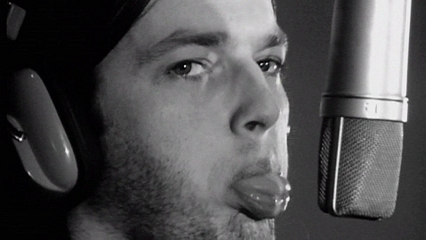 How will this sound if I record it backwards? |
• • •
"Several Species Of Small Furry Animals..."
(1969) Pictish rant
![]() "Careful With
That Axe, Eugene" (live 1972) Pictish rant
"Careful With
That Axe, Eugene" (live 1972) Pictish rant
Roger's Pictish rant in the end of "Several Species..." was repeated on stage
during extended renditions of "Careful With That Axe, Eugene" (e.g. live in Böblingen, 15 November 1972). People assumed it was somebody else ranting (Ron
Geesin's name often came up, him being a Scotsman), but it was none other than
Roger, who--according to sound engineer Peter Mew--just improvised it in the
studio. Both Geesin and Waters had Scottish mothers and English fathers, as it
happened.
• • •
Section 2 - from Zabriskie Point
to The Dark Side Of The Moon
(1970 - 1973)
• • •
"The Violent Sequence" (1969-70)
![]() "Us And Them" (1972-73)
"Us And Them" (1972-73)
The music to "Us And Them" was famously resurrected from an older piece written
by Rick on piano, originally intended to be part of the band's work for the
soundtrack of Antonioni's Zabriskie
Point. In the recent Classic Albums Documentary/DVD on Dark Side
Of The Moon, Rick
said that he wrote the main chord progression on the piano while Antonioni's
riot sequence (see picture below) was showing on screen, and that he later wrote the chords for the
chorus ("forward he cried...") in the studio, once Waters had written the lyrics.
This, in fact, is not true, as live recordings exist (e.g. the Europa 1
broadcast of the Paris, 23 January 1970 gig) which also feature the same chord
sequence as a 'middle section', without lyrics.
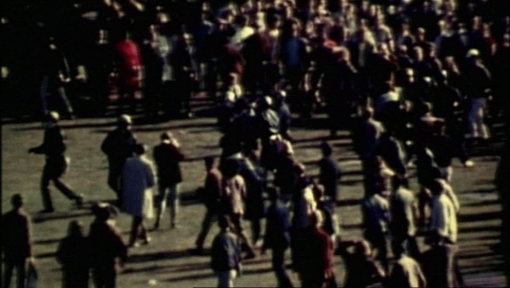 Still from the riot scene that inspired Wright's music for the "Violent Sequence". |
• • •
"Heart Beat, Pig Meat" (1970)
![]() "(Pompeii) Intro" (1972)
"(Pompeii) Intro" (1972)
![]() "Speak To Me" (1973)
"Speak To Me" (1973)
All three tracks are sound effect collages that essentially share the same
concept of tape effects spliced on top of a bass-drum beat, gradually worked
into a heartbeat-like pulse (spot the p.u.l.s.e. reference of the blinking LED).
The Pompeii "Intro" sequence also features VCS3 synth drones that were to become
part of the introduction to the 1972 Eclipse (A Piece for Assorted Lunatics)
suite (which would later become The Dark Side Of The Moon) that was eventually titled
"Speak To Me" (1973) and featured many other sound effects used in the rest of the album: clock
ticks, cash register sounds, orgasmic screams, and voice snippets.
• • •
"Atom Heart Mother: a) Father's Shout" (1970)
brass section
"Summer '68" (1970) mellotron brass solo
"Shine On You Crazy Diamond" part 1 (1975) synth 'horn' solo
"Mediterranean C" (1978) synth solo
"Wearing the Inside Out" (1994) synth solo
The first theme heard in "Atom Heart Mother"--the "a) Father's Shout" section--is
a piece for brass (performed by the Abbey Road Session Pops Orchestra) that
was arranged by Ron Geesin, inspired by the Western-like theme originally
composed for electric guitar by Gilmour. The brass arrangement possibly used
some of Rick's organ chords as a guide. Geesin has gone to some length to put
down the band's involvement in the arrangement of the suite. Geesin's credit notwithstanding, one has
reasons to suspect that Rick Wright's involvement may have been more significant
than it is believed to be. Rick always had a soft spot for jazz and for brass instruments
and his tenure in earlier (1963-65) incarnations of Floyd (Sigma 6,
The Tea Set, The Pink Floyd Blues Band and "The" Pink Floyd)
featured him playing 'brass' and saxophone, as well as the keyboards.
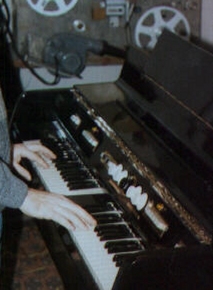 Floyd's own black Mellotron M400 Mk II. Photo taken in the 1990s while the specimen was being refurbished at Streetly Electronics, UK. |
In post-Syd Pink Floyd, he played the trombone a bit (for the live 'Work/Afternoon' aka 'Biding My Time') and has persistently favoured wind and brass instrument sounds, either with the Mellotron or with synthesizers. In "Julia Dream", he first used the Mellotron (a keyboard, which is--loosely speaking--an early 'sampler' that played back magnetic tapes with pre-recorded instruments, including strings, choir, flute, and brass) for the flute sounds. Rick also used the Mellotron brass tape set in "Summer '68" (1970) for the 'trumpet' solo. Mellotrons were notoriously volatile and Floyd never gigged or toured with their specimen (one of only six black M400 Mk II models ever made, along with the machine once owned by Princess Margaret). After Atom Heart Mother it was put into storage, where it ended up fairly badly damaged before being rescued, repaired, and subsequently resold.
Post-Mellotron, Wright used the characteristic 'synth horn/trumpet' sound with his Minimoog synthesizer, throughout "Shine On You Crazy Diamond". Then, in 1978, when he was recording Wet Dream, his first solo album, he used his first polyphonic synthesizer, the Oberheim Four-Voice Poly, for the main brass theme heard in "Mediterranean C" (which sounds like an homage to "Father's Shout" and "Summer '68"). In similar fashion, he used a synth brass sound for his solo in "Wearing The Inside Out" (1994).
• • •
"Fat Old Sun" (1970) church bell tolling
intro
![]() "High Hopes" (1994) church bell tolling intro
"High Hopes" (1994) church bell tolling intro
The church bell sounds
echo Gilmour's Cambridge youth, and the landscape which inspired the
(Gilmour-penned) lyrics of "Fat Old Sun" is also referring to Cambridge.
Also see the entry on "Grantchester Meadows" fly-buzzing noise.
• • •
"Atom Heart Mother: e) Mind Your Throats, Please"
(1970) Leslie-piano 'ping' in coda
"Echoes" (1971) pings
![]() "Hey You" (1979) pings
"Hey You" (1979) pings
![]() "What God Wants,
part III" (1992) intro pings
"What God Wants,
part III" (1992) intro pings
Controversial as it may seem, "Echoes" was not the first Floyd tune where the
piano was fed through the Leslie cabinet speaker. Listening closely towards the
end of "Mind Your Throats, Please" (after the 'train' effect and before "Remergence")
one can hear what is unmistakably loose piano notes (high and low) fed through
the Leslie, in a very similar way to the intro of "Echoes". What is often
overlooked is that the significance of the "Echoes" pings was not in the
Leslie treatment itself, but in the particular harmonic resonance of the high
piano note hit by Rick while jamming in the studio. It was that special nuance
that the band couldn't manage to recreate, and had to go back to the
original recording in order to use that particular note in the final mix.
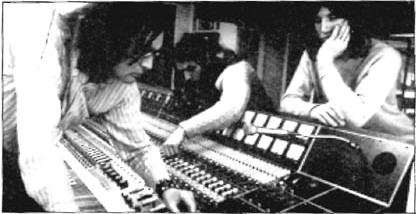 Engineer Peter Mew, Dave Gilmour, and Roger Waters in the control room of AIR Studio Two, during the Meddle sessions. Mew is adjusting controls in the monitor / control section of the Neve 16-track console, Gilmour is adjusting an echo send pot, and Waters is reluctantly observing the proceedings. The 16-track desk was the reason they used AIR studios in the first place. (Summer 1971) |
The 'ping' sounds were also used again in "Hey You" (1979), during the section after "...and the worms ate into his brain", and in the atmospheric introduction of Waters' own "What God Wants, part III" (1992), some 13 years later.
• • •
"Atom Heart Mother: d) Funky Dung" (1970)
opening guitar note
"The Embryo" (live 1970-71) opening guitar
"What Do You Want From Me?" (1994) opening guitar
The bluesy bent-and-held guitar note that opens "Funky Dung" would soon become
one of Gilmour's defining moments. He was happy to introduce live versions of
"The Embryo" in a very similar way (e.g. live 16 July 1970). And, while there
are solos aplenty which are played by Gilmour in similar style, one cannot
neglect the resemblance in the majestic way that the guitar breaks in "What Do
You Want From Me?".
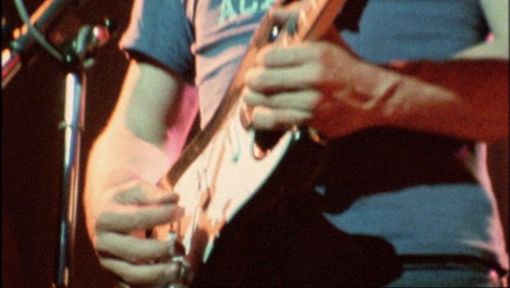 Dave's got the bends |
• • •
"Breathe In The Air" (1970)
"Breathe" (1973)
![]() "Breathe
(reprise)" (1973) coda to 'Time'
"Breathe
(reprise)" (1973) coda to 'Time'
They may be different musically but the fact of the matter is that Roger's solo
contribution to Music from The Body (1970) does at least share the same
opening line and title with the track of the same name that appeared in Dark Side... two
years later.
Also, rather more obviously, "Time" closes with a reprise of "Breathe" (the
working title of which was "Home Again"). It is mentioned as a separate track
in the lyrics and songbook but is not credited separately on the album.
• • •
"The Embryo" (live 1970-71)
'seagull' guitar
![]() "Echoes" (1971) 'seagull' section
"Echoes" (1971) 'seagull' section
"Careful With That Axe, Eugene" (live 1972) wailing guitars
"Dogs" (1977) wailing guitars behind double-harmony guitars
"Pigs (three different ones)" (1977) wailing guitars
"Is There Anybody Out There?" (1979) wailing guitars
Gilmour's patented guitar wails that were featured in "Echoes" (1971) have been
part of the middle section of an earlier tune, "The Embryo", that evolved a
lot as a live number since its conception in 1969. Once "The Return Of The Son
Of Nothing" (later "Echoes") started getting into shape, the band stopped
playing the 'seagull section' during "The Embryo" and reverted to a keyboard
solo instead. These guitar wails have, however, been echoed in other tunes as well,
albeit less prominently. On stage Gilmour would often sneak a few wails
here and there, particularly during extended stretches of "Careful With That
Axe..". Other studio tracks that featured certain 'distant', gentler wails
include "Dogs" (the 'echo' guitar licks behind the double harmony guitar
section), "Pigs (three different ones)" (1977) and "Is There Anybody Out There?"
(1979) during the track's introduction.
• • •
"Atom Heart Mother: a) Father's Shout" (1970)
guitar theme sans brass
"The Embryo" (live 20nov71) guitar improvisation
![]() "Breathe" (live 1972) rhythm guitar arpeggio
"Breathe" (live 1972) rhythm guitar arpeggio
"The Embryo" (live 20nov71) guitar
improvisation
![]() "Echoes" (1971)
funky section
"Echoes" (1971)
funky section
![]() "Travel
Sequence" (1972)
"Travel
Sequence" (1972)
![]() "Breathe" (1972-73) rhythm guitar arpeggio
"Breathe" (1972-73) rhythm guitar arpeggio
Is it not interesting to discover that the nucleus of many Floyd tunes
originated in a single Gilmour-led wildly improvised 20-minute jam? The 20
November 1971 gig at Cincinnati was "The Embryo"'s very last performance and
Floyd's last 1971 date of their tour, before they started performing the
Eclipse / Dark Side Of The Moon suite and subsequently dropped most of their
early tracks from their live set. The basis of the "Travel Sequence" jam, before
it was replaced by "On the Run", definitely owes much to this improvisation.
One can also hear a basic part of the "Breathe" main guitar arpeggiated theme.
It may not be as obvious when compared to the final studio version, because of
the studio version's pedal-steel guitar and electric piano, which are mixed higher.
However, when compared to early 1972 performances (e.g. the live 20 February
1972 version at the Rainbow Theatre, London) one can hear the similarity. If
you take the main arpeggio theme played with the guitar and add to it Rick's
intermediate minor 7th chord (inspired, as he recently said in the Classic
Albums documentary, by Miles Davis' "Kind Of Blue") you have the main
chords of "Breathe". This arpeggio has certain similarities to the main guitar
theme heard in "Father's Shout" from "Atom Heart Mother" when performed live
without the brass section (e.g. live San Diego, 18 October 1971).
While jamming that night, Gilmour effectively made a small demonstration of many
melodic and guitar-playing ideas that were a good part of his repertoire at the
time. In addition to the examples mentioned above, there is a whole passage
which sounds like the 'funky' section of "Echoes" (both the rhythm guitar part
and the frenetic octave-jumping lead work). Dave himself has often stated that
he was not going through a particularly prolific phase during the writing
(1972-73) of Dark Side Of The Moon, and that he was not satisfied by
his contribution, but--in hindsight--I really cannot see what made him think
so.
As an anecdotal side note, I have long argued that, during the 20nov71 improvisation, Gilmour also stumbled upon the main riff of "I Shot The Sheriff", four years before Bob Marley wrote it; but I realise it's more difficult to convince anyone about that! However, for those interested, there is a brief audio segment taken from that improvisation that includes the riff in question and can be downloaded here. What makes this connection even funnier is that, according to Earl "Wya" Lindo (the Wailers' keyboardist), when Marley & The Wailers came in England in 1972, they rented Pink Floyd's keyboard equipment to play on the road.
• • •
"One Of These Days" (1971) bass rhythm
![]() "The Dogs Of War" (1987) rhythm section
"The Dogs Of War" (1987) rhythm section
The pulsating bass rhythm of "Dogs Of War" (1987) and the organ 'crashes' intonating
the bars, are used in a very similar way to "One Of These Days" (1971), difficult
though it may be to make the comparison between a Floyd 'classic' and a '87 song
often voted as the worst Floyd tune ever recorded(!)
You may also wish to check the entry on the track's influence on "Welcome To The
Machine" too. The 'organ crashes' also resemble "Welcome To The Machine"'s string
synthesizer chords.
• • •
"One Of These Days" (1971) organ
"Dogs" (1977) organ
"Waves" (1978) keyboards
The fading-in Hammond chords that ascend in volume and finally 'break' in the stereo
picture
are a Rick trademark and were first used in "One Of These Days" (1971). They
were also used in very similar effect in "Dogs", behind the
strumming guitar opening (of the "You gotta be crazy" / "I gotta admit'" verses).
This technique was also subtly used in "Waves" (1978) from Rick's first solo album.
• • •
"One Of These Days" (1971) wind effect
![]() "Shine On You
Crazy Diamond" part 6 (1975) wind effect
"Shine On You
Crazy Diamond" part 6 (1975) wind effect
![]() "Dogs" / "Sheep"
/ "Pigs On The Wing" / "Welcome To The Machine" (live 1977) wind effects
"Dogs" / "Sheep"
/ "Pigs On The Wing" / "Welcome To The Machine" (live 1977) wind effects
The wind effects (often thought to be a tape effect but actually generated by
the VCS3 synth) were used to open "One Of These Days" (1971) but also "Shine On.. part
6" (1975). Howling wind sounds were used in abundance as 'atmosphere' throughout the 1977 tour, during the live set of
Animals,
"Welcome To The Machine" and "Shine On You Crazy Diamond parts 6-9".
• • •
"One Of These Days" (1971) pedal-steel guitar section
![]() "Shine On You
Crazy Diamond" part 6 (1975) pedal-steel guitar section
"Shine On You
Crazy Diamond" part 6 (1975) pedal-steel guitar section
Apart from the wind effect which is similar in both, the manic pedal-steel guitars
of "Shine On You Crazy Diamond" part 6 (1975) are clearly revisiting "One Of These Days"
(1971).
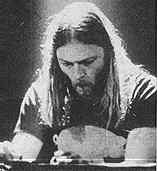
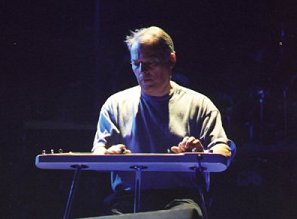 Gilmour playing pedal-steel guitar during "Shine On...
p.6" live 1977 (left) |
• • •
"One Of These Days" (1971) Dr Who theme
![]() "Cymbaline" (live 1971) Dr Who half-snippet
"Cymbaline" (live 1971) Dr Who half-snippet
![]() "Careful With
That Axe, Eugene" (live 1972) Dr Who half-snippet
"Careful With
That Axe, Eugene" (live 1972) Dr Who half-snippet
![]() "Sheep" (live 1977) Dr Who snippet
"Sheep" (live 1977) Dr Who snippet
The classic theme from Dr. Who (produced by the BBC Radiophonic Workshop in
1969, using, among other sonic innovations, the VCS3) has achieved 'cult' status
by now, but had caused quite a stir in the early seventies too--in the UK at
least. The music theme of the popular TV series was echoed during the middle 'heavy-vibrato
bass' section of "One Of These Days", but has been a Floyd fixation ever since. Gilmour added it with his slide guitar wherever he could (or at least a
snippet of it that contained the first 3 notes) most notably during live
versions of "Cymbaline" (1970-71), "Careful With That Axe, Eugene" (1970-72), and
"Sheep" (e.g. live 6 July 1977).
• • •
"Seamus" (1971)
"Mademoiselle Nobs" (live 1971)
How can we leave this one out? The truth is that you will not find "Seamus" in
many lists with Floyd's most popular songs. A joke that was probably funnier to the
band members themselves than to anybody else, this song nonetheless features Floyd's only
non-human guest vocal (flies, birds, and insects don't count). Seamus ("that's the
dog") can, indeed, sing a bit, but then again so can
Nobs,
the other dog Floyd summoned while recording some extra songs for Adrian Maben's
film Live At Pompeii--in Paris. The tune is a little bluegrass number that
(despite the Waters/Wright/Gilmour/Mason credits) probably owes more to
Gilmour than any of the other three. A note on pronunciation: 'Seamus' is an
Irish name (the Irish 'James', if you like) and so it is pronounced Shame-us.
What some readers may find significant is that the 'live' version (the one featured in Live At Pompeii) features Gilmour on blues harp and vocals and Waters on electric guitar (we wouldn't see Roger with an electric guitar in public, until the 1977 tour). Oh, and Wright is assisting the dog. Perhaps Mason's making tea.
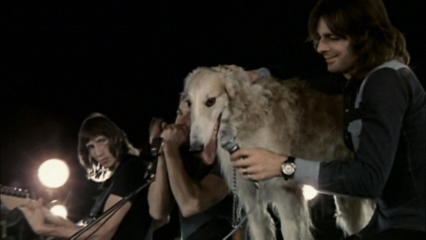 Mademoiselle Nobs stepping in Seamus' shoes. Roger playing an electric guitar, Dave with a blues harp. Rick holding the mike for the talented Mademoiselle Nobs. |
• • •
"Echoes" (1971) opening guitar
"Shine On You Crazy Diamond" part 1 (1975) opening guitar
"Signs Of Life" (1987) opening guitar
This may seem rather obvious, but the opening guitar notes of "Shine On You
Crazy Diamond" follow the same simple rules Gilmour used in the opening guitar
phrase heard in the beginning of "Echoes": clean, soft, and succinct enough to make you want to sit
back, sigh and enjoy the (audio) trip. Gilmour's licks on top of Wright's layers
of keyboards
defined a whole genre. "Shine On..." (1975) may be the most famous for the
said guitar/keyboards combination, but "Echoes" (1971) was clearly the forerunner.
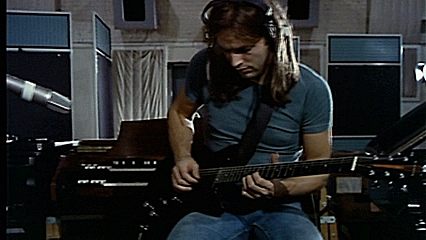 Gilmour overdubbing a guitar part in Abbey Road (1973) |
As for the opening guitar of "Signs Of Life" (originally demoed by Dave circa
1978), it is, again, quite similar to the opening guitar phrase of "Shine On...,
part 1". In fact, an edited version of "Shine On You Crazy Diamond part 1" (cut
right before 'Syd's Theme') was played live in 1987-89 (and was featured in the
Delicate Sound of Thunder video) serving as an introduction to "Learning To
Fly", in the same way "Signs Of Life" was an introduction to "Learning To Fly"
in Momentary Lapse Of Reason.
• • •
"(Pompeii) Intro" (1972) synth drones
"Obscured By Clouds" (1972) synth filter sweeps
"Speak To Me" (live 1972-74) synth sweeps & drones
"Any Colour You Like" (1973) synth filter sweeps
"Raving And Drooling" (live 1974) synth intro
"Shine On" (live 1974) synth solo intro
"Shine On You Crazy Diamond" parts 1 & 9 (1975) synth sweeps
The Introduction sequence in Live at Pompeii (1972) contained the first traces
of the familiar VCS3 synth drones that Floyd would use extensively during
1972-75. The filter sweeps and drones in the studio version of
"Obscured By Clouds" (1972), as well as the live '73-'74 performances of "Obscured By Clouds/When You're In" sound
very close to the synth intro of "Raving And Drooling" and the proto-"Shine On" 1974 versions. The same VCS3 sweeps were also used in
"Speak To Me", "Any Colour
You Like" and the intro & coda of "Shine On You Crazy Diamond" (parts
1 & 9 respectively).
• • •
"Free Four" (1972) synth drones
"Time" (1973) intro synth drones
"Any Colour You Like" (1973) synth drones
"Eclipse" (1973) synth drones
The single-note bass 'drones' produced with the VCS3 synthesizer to intonate every bar or two
were used in exactly the same manner on both "Free Four" (1972) and "Time"
(1973). "Any Colour You Like" (1973) also featured these during Rick's synth solo
(the lead synth in "Any Colour You Like" is a Minimoog -not a VCS3).
"Eclipse" also features some of the drones, although they are somewhat buried in the mix.
As a technical note, Floyd's reference to the 'VCS3' in the Dark Side credits is rather misleading. Floyd owned a VCS3 ('Putney') synthesizer since 1971, i.e. the Meddle sessions. EMS, the British company that produced it, made another model, the VSC3 Synthi A ('Portabella') which Floyd also acquired in 1972. They used both the 'Putney' and the 'Portabella' in Obscured By Clouds (1972) and the photo below shows Rick and Dave fiddling with them in the studio. By late '72-early '73 they had also acquired the sequencer-equipped Synthi AKS, which they used in "On The Run". Technically speaking, it is the 'Synthi A' and 'Synthi AKS' that are featured heavily in Dark Side Of The Moon--not the VCS3.
|
Wright fiddling with a VCS3 'Putney' synthesizer and Gilmour with a Synthi A 'Portabella' (1972) |
• • •
"Childhood's End" (1972)
"Time" (1973)
The two tunes (both written in 1972) have many similarities in song structure,
production and arrangement. The comparisons start as soon
as the strict-tempo 'clock-ticking' pattern is heard (played on both occasions
by Roger picking his Fender Precision bass pick-ups). The tempo and delivery of
the verses "You shout in your sleep...' reflect the 'Ticking away... the
moments...' verses quite closely. The lyrical theme of "Childhood's End" (proudly
penned by Gilmour alone) can also be seen as a forerunner to the fundamental issues
explored by Waters in "Time", let alone the similar ending:
"...so all things have an end, so this song will end"
"...the time is gone, the song is over, thought I'd something more to say"
The track's atmospheric introduction (another similarity with "Time") also
features what sounds like an ARP Odyssey synthesizer (used by Floyd for the
first time) possibly the one available at Strawberry Studios, in Château d'Herouville,
where Floyd recorded the album (in only a week!) and where Elton John had also just
recorded his Honky Chateau (1972) album.
• • •
"Burning Bridges" (1972)
"Mudmen" (1972)
"Mudmen" is to "Burning Bridges" what "Ibiza Bar" is to
the "Nile Song". "Mudmen"
is an instrumental based on the same melody as "Burning Bridges" (music by
Wright/Gilmour), featuring some beautiful solos by
Gilmour and Rick's first Fender Rhodes electric piano recording (Wright would
later opt
for the Wurlitzer electric piano instead, in Dark Side and Wish You Were Here). In addition
to the electric piano and organ, Rick used an ARP Odyssey synthesizer (also see "Childhood's End"
entry) to produce the synthesizer sounds heard towards the end. Before the
advent of synthesizers, Wright would resort to more primitive techniques to
achieve such sounds, like feeding his Farfisa organ through volume or wah-wah pedals
and playing the tape recording backwards--the latter
technique was used for the drones in the "Main Theme from More" (1969),
for example.
• • •
"Time" (1973) chiming clocks intro
![]() "One Slip" (1987) alarm intro
"One Slip" (1987) alarm intro
The 'shock' effect of the famous chiming clocks in the intro of "Time" is echoed
in the intro of "One Slip". The clocks were individually recorded by Alan
Parsons in 1972, while the 1987 alarm sounds were a recording of the actual
anti-theft alarm of the Astoria, Gilmour's
houseboat/studio. The alarm was triggered by engineer Andy Jackson and the bleeps
heard in the beginning are Jackson deliberately punching the wrong pass code.
• • •
"Time" (1973) roto-tom drum intro
![]() "Run Like Hell" (live 1980-81) drum middle section
"Run Like Hell" (live 1980-81) drum middle section
The introduction of "Time" features Nick playing his roto-toms (seen below), which
are sets of toms that can be individually tuned by rotating the drum on a post
which is attached to the stand. They are easy to tune (even up and down a whole
octave) and provide a crisp, clear tone. Mason's 'solo' during the "Time" intro
is a masterclass in the use of the 'pause' (or, as is often the case with
Floyd, the art of knowing when not to play). Similarly sounding high-pitched toms were
banged by Mason during the 'middle section' of "Run Like Hell" live renditions
in 1980-81.
|
Nick's Remo Roto Toms behind his impressive translucent drum kit (live 1973) |
• • •
"Money" (1973) cash register effects
![]() "Not Now John" (1983) cash register sound effects
"Not Now John" (1983) cash register sound effects
The famous cash register and coin sound effects were recorded by Roger, using a
combination of sources: throwing coins to a revolving clay pot that belonged to
his (then) wife, tearing pieces of paper, and recording the bell of
a real cash register. These were painstakingly edited on tape and manually
stretched so that they could fit to the track's unusual 7/8 time signature. The
reel tape was played in a 'loop' (another Floydian innovation there) with the
aid of a mikestand that acted as an 'extra reel' (see picture below). Roger
would use a snippet ten years later, in "Not Now John".
It is first heard after Gilmour's "we gotta compete with the wily Japanese" (at approx.
0'17") and then later, in sync with the
tempo of the song.
|
The 'reel tape-on-a-mikestand' loop for the cash
register effect in "Money" |
• • •
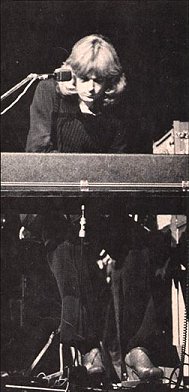 Wright playing a black Wurlitzer 200A with a Vox wah-wah pedal on stage (1974) |
"Money" (1973) electric piano through wah-wah
pedal
![]() "What Do You
Want From Me?" (1994) electric piano through wah-wah
pedal
"What Do You
Want From Me?" (1994) electric piano through wah-wah
pedal
The electric piano fed through the wah-wah pedal is similar in both tunes. So distinctive and Floydian is this Wurlitzer wah-wah sound that it makes you wonder why Rick didn't use the same treatment on more tunes from Dark Side or Wish You Were Here. While searching for other songs I was surprised to find out that it was not featured on any other tune until 1994.
• • •
"The Great Gig In The Sky" (1973) pedal-steel
guitar & piano
![]() "Marooned" (1994) pedal-steel guitar & piano
"Marooned" (1994) pedal-steel guitar & piano
The pedal-steel guitar 'ascending' pitch bend right before Gilmour starts the
Whammy pedal solo in "Marooned" is very reminiscent to the similar pedal-steel used
before Clare Torry's vocals in "Great Gig...". The (Wright-penned) piano parts in
those two tunes are not very different, either.
• • •
"Us And Them" (1973) vocal echo
"Dogs" (1977) vocal echo
"When The Tigers Broke Free" (1982) vocal echo
"Your Possible Pasts" (1983) vocal echo
"Poles Apart" (1994) vocal echo
The use of the repeating echo in "Us And Them" can be seen as the prototype for
the vocal echo of "Dogs" (1977) in "Dragged down by the stone... stone... stone". Using echo in vocals is of course common practice and there
is little point in listing every single track that makes use of it. These
examples, however, contain vocals which have, arguably, greater impact due to
the very use of repeating echo. Vocal echo was used to chilling effect in the
repeating "the rest of them dying... dying" of "When The Tigers Broke
Free" (1982) and is also evident in the "Do you think we should be
closer.. closer.. closer" passage of "Your Possible Pasts" (1983) and then again in
"Did
you know... you know... know...'" vocals in "Poles Apart" (1994).
• • •
Section 3 - from the Household Objects
to The Wall
(1974 - 1981)
• • •
Household Objects (1974) tuned wine
glasses
![]() "Shine On You
Crazy Diamond" parts 1 & 2 (1975)
wine glasses
"Shine On You
Crazy Diamond" parts 1 & 2 (1975)
wine glasses
![]() "Is There
Anybody Out There?" (1979) tuned wine glasses
"Is There
Anybody Out There?" (1979) tuned wine glasses
The abandoned Household Objects project managed to produce several incomplete segments, out of which the only one that was eventually used (according to Gilmour) was a recording of wine glasses filled with different levels of water, tuned each a semitone higher and played like a keyboard. "Shine On You Crazy Diamond" parts 1 & 2 (1975) feature recordings of at least 2 such passages. "Is There Anybody Out There?" also uses them for a crystal-like waterdrop effect and "Hey You" also had them at demo stage (in the final studio version they reverted to "Echoes"-like pings, instead).
• • •
"Gotta Be Crazy"/"You Got To Be Crazy" (live
1974-75)
![]() "Dogs" (1977)
"Dogs" (1977)
"Dogs" began life as "Gotta Be Crazy" (a.k.a. "You've Got To Be Crazy"). The lyrics changed
considerably, as did the arrangements. The middle section (which consists of vocoder-fed
ARP Solina String synth layers and VCS3 synth sweeps) was only added later in the 1976 studio sessions for Animals. The
music however (written by Gilmour, with the exception of the coda co-written by
Waters) stayed pretty much the same.
• • •
"Raving And Drooling" (live 1974-75)
![]() "Sheep" (1977)
"Sheep" (1977)
Ditto "Sheep". It began life as "Raving and Drooling". The lyrics were also
rewritten (as in the case of "Dogs") to fit the Animals concept. The basic
chords remained the same but the piece's intro, outro, arrangements and, dynamics
were given a rather different treatment in the studio (and were heavily
influenced by Gilmour's and Wright's contributions, despite the Waters-only
credit).
• • •
"Raving And Drooling" (live 1974-75) bass intro
![]() "Shine On You
Crazy Diamond" part 6 (1975) bass intro
"Shine On You
Crazy Diamond" part 6 (1975) bass intro
![]() "Sheep" (1977) bass intro
"Sheep" (1977) bass intro
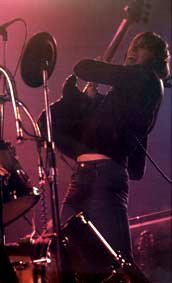 Waters live in the European leg of the 1977 tour |
Another Waters trademark, the gargling doodly-doodle bass intro that slowly
fades in and opens "Raving and Drooling" was also used to open the second part
of the "Shine On You Crazy Diamond" suite (part 6), amidst all the wind noise.
It was to be used again, of course, in precisely the same way, in "Raving and Drooling"'s later incarnation, "Sheep", where the bass fades in halfway through
Rick's Rhodes electric piano introduction.
• • •
"Welcome To The Machine" (1975) synth solo
![]() "Dogs" (1977) middle section synth solo
"Dogs" (1977) middle section synth solo
The Minimoog synth solo played in the "Dogs" middle section (starting at
approximately 10'03") is not dissimilar to the Minimoog solo in "Welcome To The Machine".
• • •
"Welcome To The Machine" (1975) pulsating
synth rhythm
![]() "The Dogs Of
War" (1987) pulsating rhythm
"The Dogs Of
War" (1987) pulsating rhythm
In a separate entry, you may read about how "The Dogs Of War" resembles
the rhythm section of "One Of These Days" too. The fact is that it actually
has a bit of both. While the rhythm starts as a rendition of "One Of These
Days" (with less attack on the bass), it gives way (after a few bars) to a more
pulsating (wabba-bly-wobbly) bass synth that resembles the throbbing
synth of
"Welcome To The Machine". Listen and take your pick.
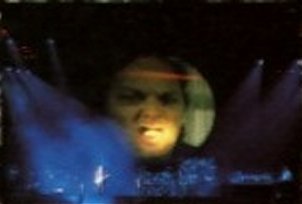 A glimpse of Gilmour from the "Dogs Of War" video projection (live 1988) |
• • •
"Welcome To The Machine" (1975) middle
section guitar line
![]() "Colours Of
Infinity" (1992) guitar line
"Colours Of
Infinity" (1992) guitar line
![]() "High Hopes" (1994) middle section guitar line
"High Hopes" (1994) middle section guitar line
The 'ascending' line played with a nylon-string classical guitar that is heard
in the middle section of "High Hopes" (1994) is very similar to the guitar line
of "Welcome To The Machine". The arrangement of "High Hopes" also borrows some
of the The Wall atmosphere, with the military snare drum and the
orchestral backdrop from "Bring the Boys Back Home".
The "High Hopes" nylon-string guitar theme had actually been recorded by Gilmour as part of his Colours Of Infinity project, which was recorded before The Division Bell. The guitar-and-synth-flute theme is heard before Sir Arthur C. Clarke says: "...well, these pictures are all very pretty, but what's of practical value?". You can download an audio snippet here.
• • •
"Welcome To The Machine" (1975) people
noises coda
"The Trial" (1979) 'opening door' intro & chanting
![]() "What God Wants, part I" (1992) 'opening door' & chanting intro
"What God Wants, part I" (1992) 'opening door' & chanting intro
Upon entering the imaginary 'courtroom' of "The Trial" (1979) a creaking door
opens and reveals the noises from inside. This is exactly what happens in the
intro of Roger's "What God Wants, part I" (1992). Additionally, there's a
chanting that harks back to the "Pink Floyd"/"Hammer" chanting of The Wall,
heard in the segues between "Run Like Hell" and "Waiting For The Worms". Of
course the idea of the 'door opening' and revealing people noises inside first
appeared at the very end of "Welcome To The Machine" (once the machine noises
are over).
• • •
"Have A Cigar" (1975) rhythm section
"Pigs (three different ones)" (1977) rhythm section
"What Do You Want From Me?"
(1994) rhythm section
One could say that the 'funky' rhythm section on the 1975 classic is echoed in
"What Do You Want From Me?" (1994). A similar template was used for the
(intrinsically more complex) "Pigs (Three Different Ones)" in 1977.
• • •
"Wish You Were Here" (1975)
![]() "On The Turning
Away" (1987) chorus
"On The Turning
Away" (1987) chorus
![]() "Lost For Words" (1994)
main chords & arrangement
"Lost For Words" (1994)
main chords & arrangement
The 12-string acoustic guitar riff backdrop followed by the 2nd acoustic guitar soloing
on top of it is a straight
giveaway that reveals how much "Wish You Were Here" (1975) was the inspiration
behind "Lost For Words" (1994). It is so obvious that makes you think Gilmour
did it on purpose, as part of The Division Bell's overall revisiting theme.
What "Lost For Words" does not have in common with "Wish..", however, is
the chorus. And that is where Gilmour's epic sing-along anthem, "On The Turning
Away" (1987) steps in to fill the void. The 'power ballad' arrangement of "On
The Turning Away" is different to "Wish..", but if you try and imagine "On The
Turning Away" played in an acoustic guitar, by the fire, on a summer night, the
similarities would become obvious.
• • •
"Pigs On The Wing" (1977)
"Mother" (1979)
When discussing similarities between songs it is often easy to get carried away; this article is certainly not an exception to that. Upon analysing a song in its bare-bones basic structure, you are likely to discover that it resembles myriads of other tunes. This is to be expected. Besides, there is only a finite amount of chord combinations we can use and the musical vocabulary is common to us all. This is why the arrangement (which part is played by what instrument, and how, etc.) and the production ideas of a song ultimately make the difference. Most entries in this article are not about identical chord progressions, but about 'similar feel' or ideas used in songs. That is to say, if we had access to all of Roger's demos with him strumming an acoustic guitar, then chances are we would conclude that half of his songs remind us of the other half.
"Pigs On The Wing" (either "1" or "2") is an example where Roger plays and sings in a way that reveals chord and metre similarities to "Mother" (excluding the latter's "hush now baby, baby don't you cry" chorus). So, without reading too much into such similarities, one could say that both tracks resemble each other, as do other acoustic-based tunes too.
• • •
"Pigs On The Wing 1" (1977)
"Pigs On The Wing 2" (1977)
"A New Machine, part 1" (1987)
"A New Machine, part 2" (1987)
"What God Wants, Part I" (1992)
"What God Wants, Part II" (1992)
"What God Wants, Part III" (1992)
"Late Home Tonight, Part I" (1992)
"Late Home Tonight, Part II" (1992)
"Pigs On The Wing" is one tune split in two halves, book-ending the Animals album.
By no means a Floyd invention, this was the norm by many progressive acts of the
1970s, back in the heyday of 20-minute-plus suites, where many albums contained
'part 1' on side A of the vinyl and 'part 2' on Side B (e.g. Jethro Tull's
Thick As A Brick (1974), Mike Oldfield's Tubular Bells, Ommadawn and other
electronic acts like Tangerine Dream, Jean Michel Jarre
et al.). By the end of the 70s, however, the norm was to split the longer pieces
into smaller segments, as done by the Floyd too, in The Wall. Since the 1980s,
splitting a track in many parts was regarded as particularly unfashionable.
Floyd, however, kept the tradition way into the 1990s. Both Gilmour (with "A New
Machine" parts 1 & 2) and Waters with several multi-part tracks from Amused To
Death (1992).
• • •
"Dogs" (1977) coda guitar riff
"Another Brick In The Wall" (1979) motif
![]() ...part 1 (1979) melody
...part 1 (1979) melody
![]() ...part 2 (1979) melody
...part 2 (1979) melody
![]() ...part 3 (1979) melody
...part 3 (1979) melody
![]() "Hey You" (1979) melody behind guitar solo
"Hey You" (1979) melody behind guitar solo
![]() "Waiting For The
Worms" (1979) guitar riff
"Waiting For The
Worms" (1979) guitar riff
![]() "The Trial" (1979) guitar behind judge's verdict
"The Trial" (1979) guitar behind judge's verdict
Starting with the more obvious influence, the melody of "Another Brick In The
Wall" is used throughout The Wall as a recurring theme, in an almost operatic way,
where one or more particular motifs find their way in the play and reappear as
the story goes on. Indeed, this use of the 'leitmotif' that defines the piece
has been used throughout, establishing a theme and thus a particular mood that
permeates the record. In The Wall, the "Another Brick" motif is repeated
across all 3 parts and also in "Hey You" (behind the guitar solo), "Waiting For
The Worms" (the main grungy riff) and behind the judge's 'verdict' in "The
Trial", among other tunes. A similar approach (suggested by Mason, no less) was
used in The Final Cut where the "What have we done? Maggie, what have
we done?" theme that is
heard in the opening track "The Post War Dream" was also used in other tracks of
the album. In fact, the "Maggie, what have we done" motif is not very different
to the melody of "Outside The Wall". The Wall motif, with the almost hard-rock
grungy style and riff structure, owes to the ending section of "Dogs" ("Who
was... born in a house... full of pain..") which also features a similarly used
'grungy' guitar riff.
• • •
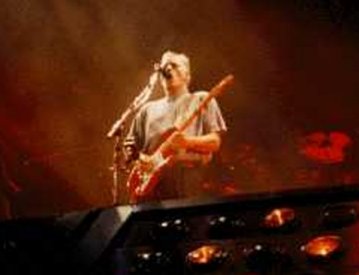 Gilmour using a Heil talk box in "Keep Talking" (live 1994) |
"Pigs (3 different ones)" (1977) talk box solo
"Keep Talking" (1994) talk box solo
The fact that Dave used a Heil talk-box on both tracks doesn't necessarily make them
related, but these two tracks have been the only cases in the entire Floyd canon
where Dave used that device/technique. Moreover, they both sound
appropriately chilling and sinister in Dave's hands (and mouth), as opposed to
'lighter' examples by other artists, like Peter Frampton or Frank Zappa, who
have also recorded with such a device.
• • •
"Sheep" (1977) organ in middle section
![]() "Don't Leave Me
Now" (1979) organ chords
"Don't Leave Me
Now" (1979) organ chords
The Hammond one-bar-in/one-bar-out chords heard before the psalm section
(at approximately 6'19") are
also used in "Don't Leave Me Now" (with the breathing effects).
• • •
"Sheep" (1977) synth lines in middle
section
![]() "Another Brick
In The Wall (part 1)" (1979) ascending synth melody in
the coda
"Another Brick
In The Wall (part 1)" (1979) ascending synth melody in
the coda
The double Minimoog synth lines before the 'bastardised psalm' middle section of
"Sheep" (starting at approximately 5'48") seem like the inspiration behind the Prophet synth chords that ascend
and wash away towards the end of "Another Brick... (part 1)".
• • •
"Sheep" (1977) final guitar-riff coda
![]() "Cry From The
Street" (1978) guitar/synth coda
"Cry From The
Street" (1978) guitar/synth coda
The way that Gilmour's "Cry From The Street" breaks into a synth/guitar riff that fades out is very
similar to the ending of "Sheep".
• • •
|
David Gilmour (1978) had moments influenced by
Animals |
"Raise My Rent" (1978) rhythm guitar
arpeggio
![]() "What Do You
Want From Me?" (1994)
"What Do You
Want From Me?" (1994)
The rhythm guitar chord progression is almost identical between the tracks.
• • •
"Short and Sweet" (1978)
![]() "Run Like Hell" (1979)
"Run Like Hell" (1979)
The main riff of "Run Like Hell" is basically the same D-root thrashing chords of
"Short and Sweet" (1978) plus the delay effect. This was confirmed by Gilmour, who
was happy to admit in an interview: "it's part of my musical repertoire, yes".
• • •
"Short and Sweet" (1978) melody behind the
verses
![]() "Big Theme" /
"Small Theme" / "Country Theme" (1992) melody
"Big Theme" /
"Small Theme" / "Country Theme" (1992) melody
The 'theme' from La Carrera Panamericana is a motif that resembles Gilmour's
"Short And Sweet" (1978), in different arrangements. Acoustic and slide guitar for the
"Country.." flavour, and more synthesizer-based backing with guitar on top for the
other two sizes: "Big..." and "Small...quot;. The strumming of the theme also resembles
Gilmour's 1984 tune "Out Of The Blue".
• • •
"Another Brick In The Wall (part 1)" (1979)
pizzicato delay guitar
"The Happiest Days of our Lives" (1979)
pizzicato delay guitar
"Another Brick In The Wall (part 3)" (1979)
delay guitar coda
"Run Like Hell" (1979) delay guitar
"The Hero's Return" (1983) delay rhythm guitar
"One Slip" (1987) delay rhythm guitar
"Mexico '78" (1992) delay rhythm guitar
"Keep Talking" (1994) delay rhythm guitar
"Take It Back" (1994) delay rhythm guitar
The echo/delay effect in Gilmour's guitar that makes "Another Brick.. (part 1)" so
characteristic has become an instantly recognisable Floyd trademark, despite the
fact that Gilmour was not the first one to use it (Ash Ra Tempel have
been recording echoing guitar cross-rhythms since 1975). Still, this chugging
guitar rhythm defined the early 80s and has been a staple in other tracks like the
"Eye Of The Tiger", for example. Steven Wilson
also paid tribute to
this, by pinching the 'pizzicato delay' guitar in Porcupine Tree's "Voyage 34"
(1992). The Wall makes frequent use of many recycled musical themes, so this
chugging guitar rhythm could not be an exception: it was used in the live
'improvisations' that were known as "Almost Gone" (later officially titled "Last
Few Bricks") during the 1980-81 Wall shows. It also formed the basis for "Run
Like Hell". The 1978 Britannia Row demos of The Wall reveal
Gilmour's experimentation with guitar delay and loops to a greater extent than
on the final versions that appeared in the 1979 release. The demos of "The
Happiest Days Of Our Lives" and "Another Brick... part 2" (before the latter's
addition of the schoolboy choir and the disco drum beat) were also full of the
delay-guitar chugging riff, nearly identical to "part 1". As for "Another
Brick... part 3", it was based on Gilmour's multiple interlocking delay-guitar
loops, a glimpse of which is heard in the studio version's coda of "part 3",
towards the end.
The 'ping-pong' feel of the guitar riffs in "Another Brick In The Wall (part 1)"
and "Run Like Hell" works because of the delay effect. "The Hero's Return" also
features rhythm guitar in an identical way, and delay-heavy chugging guitar
rhythm patterns were used by Gilmour later in "One Slip" (1987), "Mexico '78"
(1992) and "Keep Talking" (1994). "Take It Back" (1994) also uses this
technique, although in that case it sounds closer to something The Edge would
have done with U2 in their Unforgettable Fire/Joshua Tree period. But then
again, The Edge has used Gilmour's licks as an inspiration quite a few times,
most notably in the solo of "Bullet the Blue Sky" (1987) which owes quite a lot
to Gilmour's solo in the 'funky section' of "Echoes" (1971).
• • •
"Empty Spaces" (1979)
"What Shall We Do Now?" (1979)
Both share the same music. Or, to be more precise, "Empty Spaces" has the same
music as the introduction to "What Shall We Do Now?". Originally, "What Shall We
Do Now?" was supposed to be included in The Wall (its lyrics were even printed
on the sleeve), while "Empty Spaces" would reappear as a reprise. Due to space
considerations it was omitted from the final album, but remained part of The
Wall's live format. Floyd performed it live in 1980-81 and Roger included in his
performance of The Wall in Berlin (1990). The track also appears in the
Music
From The Film (1982). The melody of "Empty Spaces"/"What Shall We Do Now?"
is more or less based on The Wall motif that also lends itself into the
melody of "In The Flesh" (which, in turn, was echoed in Pros And Cons Of
Hitch Hiking as we shall see in the next section).
• • •
"Mother" (1979) phone ringing intro
"Young Lust" (1979) coda / "One Of My Turns" (1979) phone
ringing intro
"The Final Cut" (1983) coda / "Not Now John" intro
(1983) pulse phone dialogue
"What God Wants, Part III" (1992) phone ringing coda
The sounds of phones ringing permeate most of The Wall, echoing the
"when I try to get through/on the telephone to you/there'll be nobody
home" concept.
Towards the end of "The Final Cut" and before Gilmour's "f**k all that"
verse, a number is dialled and a voice can be heard on the phone.
Roger's post-Wall projects often have to do with phones. During his Radio K.A.O.S.
tour (1987) he also had the ingenious idea of setting up 'phone-in' sessions
with the audience. A phone is also heard ringing at the coda of "What
God Wants, Part III" (1992) quite appropriately, after Roger's lyric "...and
answer the phone".
Perhaps less significantly, Gilmour also used the phone-related "Charlie" segment (featuring the voice of Floyd's late manager Steve O'Rourke, hanging up after trying--unsuccessfully--to converse with Charlie, Gilmour's stepson) at the very end of The Division Bell (1994).
• • •
|
"Not Now John (obscure version)" single cover |
"Another Brick In The Wall (part 2)" (1979)
bass line & guitar solo
![]() "Not Now John" (1983) bass line & guitar solo
"Not Now John" (1983) bass line & guitar solo
![]() "Keep Talking" (1994) bass line & guitar solo
"Keep Talking" (1994) bass line & guitar solo
The bass line in "Not Now John" (1983) is very similar to the bass line from "Another
Brick In The Wall (part 2)" (1979). "Keep Talking" (1994) also features a bass line that is, in
turn, very similar to the one in "Not Now John".
Furthermore, the 1994 guitar solo shares quite a few Gilmour-esque trademarks
and 'mannerisms' with the 1979 one, both in structure and playing style. The
solo in "Not Now John" also stems from the same solo structure and style. While
it is not obvious that these three tracks share a common blueprint, upon closer
inspection they do have quite a few similarities.
• • •
"The Happiest Days Of Our Lives" (1979) bass
line & percussion
"Another Brick In The Wall (part 1)" (1979) chugging guitar
"Don't Leave Me Now" (1979) echoing guitar chords
"Run Like Hell" (1979) synth solo line
"Young Lust" (1979) guitar riffs
"Empty Spaces" (1979) guitar & synth melody lines
![]() "Almost
Gone"/"Last Few Bricks" (live 1980-81)
"Almost
Gone"/"Last Few Bricks" (live 1980-81)
As The Wall shows progressed, the improvised segue that Floyd played in the
first set, to compensate for any variations in the speed of building the wall,
evolved from a blues-based jam to a reprisal of themes heard in the album.
During The Wall rehearsals in Paramount Studios (Jan-Feb 1980), this piece
consisted of a synth sequence with added elements of what sounded like the
sped-up chord progression from "Don't Leave Me Now". A steady bass drum was
added on top of which a Prophet synth solo was played in a similar vein to
"Run
Like Hell". The same pattern was used in the shows too, although the synth sequence
was not as prominent as in the rehearsals. The bass/hi hat/drums of "The
Happiest Days.." followed, complete with the same bass line and, after some
jamming, the "Empty Spaces" motif was reprised with its powerful crescendo, and
the "Young Lust" riff dynamically closed the cycle before giving way to "Goodbye
Cruel World", the set's final number. Variations did apply, of course, and
as Mike McInnis has once written, the first show's improvisation may have indeed
been the last 'true' improvisation of the band with that line up. But, by and
large, this tune comprised of the main 'ingredients' mentioned above, all into
one melting pot. This is
Floyd recycling at its best!
• • •
"Is There Anybody Out There?" (1979) vocal
![]() "Bring The Boys
Back Home" coda
/ "Comfortably Numb" (1979) intro vocal
"Bring The Boys
Back Home" coda
/ "Comfortably Numb" (1979) intro vocal
The 'Time to goooo...' introduction to "Comfortably Numb" (coda of "Bring
The Boys Back Home") reprises the vocal intro of "Is There Anybody Out There?".
• • •
"Comfortably Numb" (1979) chorus strings
![]() "The Final Cut" (1983) strings
"The Final Cut" (1983) strings
The strings melody backdrop (during the 'there is no pain...' section) is
near-identical to the one used again in "The Final Cut". This may
or may not have to do with the fact that Michael Kamen was responsible for the
particular string arrangement in The Wall, and was a lot more in charge for
the keyboards and strings in The Final Cut.
• • •
"Run Like Hell" (1979) synth solo
![]() "Along The
Shoreline" (1996) synth solo
"Along The
Shoreline" (1996) synth solo
One of the few cases where there is tangible proof that Rick Wright did perform this synth solo
(the only 'proper' synth solo spot on The Wall), as opposed to Bob Ezrin, Pete
Wood, Freddie Mandell, and others who also provided keyboard/synth
overdubs in the 1979 sessions. Rick used the Prophet V, the main
polyphonic synth used throughout The Wall and, according to Rick's
admission, his "favourite synth". That particular
'phat' moog-like synth sound was also used in "Along The Shoreline" from his Broken
China (1996) solo album.
|
Wright with a Prophet V synthesizer stacked on top of a Hammond B-3 organ (live 1980-81) |
• • •
"In The Flesh?"/"In The Flesh" (1979) melody
![]() The Pros And
Cons Of Hitch Hiking (1984) melody
The Pros And
Cons Of Hitch Hiking (1984) melody
The melody of "In The Flesh" reappears, with different arrangement, in
most tracks from Pros And
Cons Of Hitch Hiking (1984). Try to imagine how the opening track "4:30AM
(Apparently They Were Travelling Abroad)" would sound if it
was performed with distorted electric guitar. You guessed right: "In The
Flesh".
• • •
"Don't Leave Me Now" (1979) melody
![]() "4:39AM (For The
First Time Today - Part 2)" (1984) melody and 'chorus'
"4:39AM (For The
First Time Today - Part 2)" (1984) melody and 'chorus'
The "Ooooooh babe" and the three-note melody that follows is pretty much
identical to the respective line from "Don't Leave Me Now".
• • •
Section 4 - from The Final Cut to
Broken China
(1982 - 1996)
• • •
"Stop" (from the film - 1982) Pink's monologue
![]() "Your Possible
Pasts" (1983) some verses
"Your Possible
Pasts" (1983) some verses
![]() "5:11AM (The
Moment Of Clarity)" (1984) some verses
"5:11AM (The
Moment Of Clarity)" (1984) some verses
In the film version, 'Pink' cites verses that would later surface on "Your
Possible Pasts" from The Final Cut (1983) and also in Pros And
Cons Of Hitch Hiking (1984). What is significant here is that the title
The Final Cut was originally supposed to be given to the "Spare Bricks"
project of the music from the film. In fact, the single "When The Tigers Broke
Free"/"Bring The Boys Back Home" (1982) included the subtle, albeit inaccurate,
'plug': "from the forthcoming album The Final Cut". While
Waters, Gilmour, Kamen and Guthrie worked on the film soundtrack in Pinewood
studios in London, Margaret Thatcher embarked on the Falklands war, thus
inspiring Roger to transform The Final Cut project into a more independent entity.
• • •
"The Post War Dream" (1983) motif
![]() "Southampton
Dock" (1983) motif
"Southampton
Dock" (1983) motif
![]() "The Final Cut" (1983) coda motif
"The Final Cut" (1983) coda motif
The "What have we done? Maggie, what have we done?" motif permeates the
album. You may also wish to see the entry for "Another Brick In The Wall (part
1)" motif and how it is featured in The Wall album and live shows.
• • •
"Your Possible Pasts" (1983) opening
riff
![]() "5:11AM
(The Moment Of Clarity)" (1984) opening riff
"5:11AM
(The Moment Of Clarity)" (1984) opening riff
The opening guitar 'riff', finger-picking and strumming style (in G)
of "Your Possible Pasts" is used as the main 'theme' throughout Pros And
Cons Of Hitch Hiking but perhaps most prominently in the opening guitar of
the last track: "The Moment Of Clarity".
• • •
The Final Cut (1983) sound effects
![]() The Pros And Cons Of Hitch Hiking (1984) sound effects
The Pros And Cons Of Hitch Hiking (1984) sound effects
"Get Your Filthy Hands Off My Desert" (1983) bomb effect
![]() "Perfect Sense,
Part II" (1992) bomb explosion
"Perfect Sense,
Part II" (1992) bomb explosion
Cars passing by, doors slamming, bombs exploding, manic laughter... Floyd's musique concrète-type
sound effects have always been prominent (particularly since The Wall) but
there is something about The Final Cut's effects that makes it stand out. And they reappear in
Pros And Cons... (1984) and Amused To Death (1992). The bomb explosion and
passing-car sounds, in particular,
have almost become part of Roger's repertoire. I can't wait to hear the Croatian
taxi-driver sound effects of his next
concept album(!).
• • •
Most tracks from The Pros And Cons Of
Hitch Hiking (1984) ...
... most tracks from The Pros And Cons Of Hitch Hiking
(1984)
Ultimately, it does not take long for the listener to arrive at the conclusion that pretty much all tracks off Pros
And Cons resemble one another. The truth is that, with the possible exception of
two distinguishable 'tunes' ("The Pros And Cons Of Hitch Hiking - Part 10" and "Every Stranger's Eyes"),
the rest of Pros And Cons is, from a musical standpoint, almost
identical. Same key, same melody, same predictable crescendo moments,
...everything. Moreover, the said music is not even original to the record, as
it is essentially based on the melody of "In The Flesh" (and other Wall
motifs echoed elsewhere in the album), while there is also a hell of a lot in
common with The Final Cut (1983): the overall production (again by Waters
and Michael Kamen--minus James Guthrie who was not involved with the project);
the extreme sonic dynamics (nearly inaudible passages followed by bombastic
exclamations) which, again, employed Zuccarelli Labs' Holophonics,
engineered by Andy Jackson who was Guthrie's assistant in The Final Cut.
Also, Roger's histrionic vocal delivery, screams and overstressed consonants;
the album's instrumentation with Michael Kamen's piano and Final Cut-esque
harmonium/organ & orchestral arrangements, as well as Andy Newmark's ("Two Suns
In The Sunset") drums, and Raphael Ravenscroft on saxophone/horns.
• • •
The Pros And Cons Of Hitch Hiking (1984)
"Near The End" (1984)
|
About Face and Pros and Cons Of Hitch Hiking (1984). |
The music on Pros And Cons (if we assume that all of Pros And Cons is pretty much the same tune) is similar to the music of Gilmour's "Near The End". Roger was particularly fond of singing while strumming away on a G (e.g. "Your Possible Pasts") and it so happens that "Near The End" doesn't stray away from that pattern either. The difference here is that the guitar, melody and vocal in "Near The End" is very similar to Pros And Cons (or perhaps the other way round). Those who wish to read more into this are reminded that Roger had initially presented the band with the demos of Pros And Cons as well as The Wall and that, apparently, Gilmour et al. worked on Pros And Cons tracks "a bit". To what degree this is true, we do not really know. If indeed Gilmour worked on them, then it's a shame that Pros And Cons doesn't come across stronger than it does.
• • •
"Out Of The Blue" (1984) piano break
![]() "Country Theme" (1992) strumming
"Country Theme" (1992) strumming
![]()
![]() "Lost For Words" (1994) ending
"Lost For Words" (1994) ending
While the theme's motif is based on the melody of "Short and Sweet" (1978), the
acoustic arrangement in particular resembles the piano 'riff' heard after the
main verses of "Out Of The Blue" (1984). There's something in the strumming that
resembles that rhythm too. A similar style was used in the strummed chords that
close "Lost For Words" (1994).
• • •
|
Identity (1984), Blue Light (1984), Radio Waves (1987) |
David Gilmour - "Blue Light" (1984)
Zee - "Cönfusion" (1984)
Roger Waters - "Radio Waves" (1987)
With all due respect to '80s music lovers, I picked these tracks not because I
believe they were influenced by each other, but because all three are sadly (and
regrettably) influenced *too much* by the Sequencer/Brass/Big-Drum-Sound synth
pop culture of the mid-80s. All three are disposable pop tunes and not a lot
more than that, I'm afraid. The over-reliance on sampler/synth equipment of the
day and the heavy use of Yamaha DX7, Fairlight, E-mu, etc. put an indelible time
stamp on these records; which is why they sounded 'dated' immediately
afterwards; a stark contrast to the timelessness of Floyd's catalogue. Whether
About Face, Identity, and Radio K.A.O.S. contained good tunes (they mostly
didn't) is beside the point. In this case it is the *production* of the
tracks that ultimately lets them down. But don't just take my word for it:
all of them have repeatedly topped 'worst Floyd solo' polls. Wright has dismissed the Zee project as an "experimental mistake";
"Blue Light" has been dubbed by Gilmour as "...not particularly deep and
meaningful, that one..."; whereas
Waters has said about K.A.O.S.: "between me and Ian Ritchie,
the producer, we really fucked this record up." At least they admit it
themselves! To be fair to Radio K.A.O.S., which probably contains the strongest
material of the three (at least in terms of lyrical significance), a different
production could have made a very big difference. The live performances of "The
Powers That Be" in 1999-2000, indeed, prove this.
• • •
When The Wind Blows (1986)
![]() Radio K.A.O.S. (1987)
Radio K.A.O.S. (1987)
Several tunes from Radio K.A.O.S. (1987) seem to have originated in Roger's work for
"When The Wind Blows" (1986). The acoustic motif of "Me Or Him", in particular
(which, in itself, is similar to "Brain Damage") is similar to the motif in
When The Wind Blows. Also, the ticking bomb theme of
"Four Minutes" would not be out of place in When The Wind Blows (1986).
|
When The Wind Blows (1986) and Radio K.A.O.S. (1987). • • • |
|
Gilmour triumphantly wraps up a live solo (1988) |
"Sorrow" (1987) studio guitar solo
![]() "Comfortably
Numb" (live 1987-90 / 1994) guitar solo
"Comfortably
Numb" (live 1987-90 / 1994) guitar solo
When played live, "Sorrow" includes a guitar theme that opens and closes
the song. In the studio version, however, the guitar solo just fades out. That
(studio) solo has a climactic guitar phrase at the very end, which Gilmour does
not play live. Instead, he has lifted that section and has added it to the never-ending live solo of
"Comfortably Numb"
towards the final crescendo. You can hear it in Delicate Sound Of Thunder
(1988), Knebworth '90 (1990), and p.u.l.s.e. (1995).
• • •
La Carrera Panamericana (1992)
"One Of These Days" (1971)
![]() "Pan Am Shuffle" (1992)
"Pan Am Shuffle" (1992)
"Shine On You Crazy Diamond" part 3 (1975)![]() "Carrera Slow Blues" (1992)
"Carrera Slow Blues" (1992)
"Run Like Hell" (1979) / "One Slip" (1987)
delay guitar exercise![]() "Mexico '78" (1992)
"Mexico '78" (1992)
"Short and Sweet" (1978) / "Out Of The Blue" (1984)![]() "Big..." / "Small..." / "Country Theme" (1992)
"Big..." / "Small..." / "Country Theme" (1992)
In October 1991, Gilmour, Mason, and O'Rourke took part in the La Carrera
Panamericana motor race in Mexico and sealed their involvement by producing
the video documentary and providing a soundtrack.
Apart from older Floyd tracks (some more recent than others) like "Run Like
Hell", "Sorrow", "Yet Another Movie", "One Slip", etc. there are, essentially, 4
'new' tracks in La Carrera Panamericana (1992). Those tracks are: "Pan Am Shuffle",
"Carrera Slow
Blues", "Mexico '78" and a "Theme", which comes in 3 sizes and flavours: "Big",
"Small" and "Country". The origins of the "Theme" are examined in a separate
section. "Pan Am Shuffle" and "Carrera Slow Blues" are
Gilmour/Mason/Wright compositions (the first in 19 years--since "Any Colour You
Like") and were, basically, self-homages: a bluesy pastiche of "One Of
These Days"; and a space-blues pastiche of "Shine On You Crazy Diamond" part 4.
"Mexico '78", on the other hand, was one of Gilmour's delay-guitar exercises,
faithful to the spirit of "Run Like Hell" and "One Slip" that we've examined
earlier.
As much as I'd like to argue that these pieces were recycled in 'a good way',
all I can think is "haven't I heard that before?". Jams with guitar, Hammond
organ and drums,
loosely (or not so loosely) based on familiar Floyd themes, soaked in a rather 'contemporary late '80s' (think
Delicate Sound Of Thunder)
'big snare drum' production.
• • •
Ruby Takes
A Trip (1991) / The Colours Of Infinity (1992)
"One Of These Days" (1971)
"Obscured By Clouds" (1972)
"On The Run" (1973)
"Shine On You Crazy Diamond"
parts 1,3,6 (1975)
...blueprints
![]() "High Hopes"
(1994)
"High Hopes"
(1994)
It hurts me to say that Gilmour was personally involved in these two projects. Some of his disposable '80s session work can be easily forgiven (as easily as it has been forgotten). But this? This is different. We were into the 1990s and Gilmour was solely responsible for the 'incidental music' (thats 'soundtrack' to you and me) of two TV documentaries: Ruby Takes A Trip (with comedian Ruby Wax) was aired by BBC2 TV in December 1991, and The Colours Of Infinity, a documentary on Fractals and the Mandelbrot set, in 1992. So what did Gilmour do? He employed trademark Floyd 'blueprints' ("One Of These Days", "Shine On You Crazy Diamond" part 3 & part 6, even the intro groove from "Obscured By Clouds" ) and by using his guitar as the main focal point (nothing unexpected here) he provided backing tracks clearly made on a digital sampler (including synth pads and sampled percussion) of the shockingly 'generic' kind. Even demos for Momentary Lapse Of Reason sounded less 'plastic' than The Colours Of Infinity. The melodies were near-identical to those of the aforementioned Floyd counterparts, transposed to a different key. For Ruby Takes A Trip, Gilmour even added to his Floyd pastiches a synthesizer sequence remarkably similar to "On The Run". The quality, timbre, and instrumentation of both works is very similar, which makes me speculate that the music for both soundtracks originated from the same sessions. If that is true, their recording would both be recorded circa 1991, i.e. around the same time La Carrera Panamericana was also recorded. It is also likely that Jon Carin may have given Gilmour a hand, judging by Carin's online biography which includes 'film projects with David Gilmour'.
|
Creatively speaking, Gilmour decided to use the same old palette for his Colours Of Infinity... |
I would have to say for these two that they are the closest thing to an elevator muzak version of Floyd, and then again one that you'd hope would be performed by a bad cover band. Only in this case, the music was actually performed and produced by the man himself, his guitars, and his (or Carin's) digital sampler.
The majority of this article analyses recycled themes, music and production/arrangement ideas in Floyd's discography as a positive and even creative thing. Sadly, Ruby Takes A Trip, The Colours Of Infinity, and La Carrera Panamericana are exceptions to that. There is very little new here and I would be surprised if the recording of Ruby Takes A Trip and The Colours Of Infinity, in particular, took Gilmour more than a day's worth of effort. A book and DVD of The Colours Of Infinity has been announced, so readers will be able to judge by themselves. In contrast to the rehashed music mentioned above, it has to be said that The Colours Of Infinity included an early version of the flamenco guitar of "High Hopes", probably before it was recorded for The Division Bell (1994). You can download an audio snippet here.
• • •
"Take It Back" (1994) e-bow intro
"Keep Talking" (1994) e-bow intro
During The Division Bell sessions, Gilmour was experimenting with the sounds
that can be produced with an E-bow on a
Gibson J-200 acoustic guitar, processed through a Zoom effects box. After various treatments, the band decided
not to go any further with it and Jon Carin sampled it, so it was
later added to the introduction of "Take It Back" and "Keep Talking". What we
hear in the introductions of both tracks is the same sample.
|
The main line-up of latter-day Floyd projects |
• • •
"Poles Apart" (1994) 'carousel' waltz
sequence
![]() "Breaking Water" (1996) 'carousel' sounds
"Breaking Water" (1996) 'carousel' sounds
Although "Poles Apart" is a Gilmour/Samson tune, Rick Wright's influence
is
evident in the track too. He was the one who insisted on adding the whimsical middle section,
with the waltz-like keyboards and the carousel sounds. These would be later
echoed in the atmospheric opening track "Breaking Water" of his Broken
China solo album(1996). It is worth remembering that Broken China
still is, at the moment of writing, the last complete offering of new material
by a Floyd member, excluding Gilmour's In Concert and Waters' In The
Flesh-Live and Flickering Flame which, combined, contained a total of three new
songs.
• • •
This concludes the analysis on recycled material and 'recurring' ideas in Floyd's catalogue. Keen-eyed readers may have noticed the absence of Nick Mason's collaborations, and perhaps some other entries that they expected to see in such a feature; let alone those entries that they did not expect to see and they find utterly superfluous, unnecessary, or just plain wrong. There is a certain amount of subjectivity involved, so I apologise if my views on Pros And Cons, About Face, Identity, K.A.O.S., Carrera Panamericana, and Colours Of Infinity appear to be hard-handed. The purpose of this analysis was obviously not to judge the merits of each work, but rather to assess their influences, when compared to some of the band's earlier material.
It is clear that Pink Floyd kept recycling themes, music, and 'mood' ideas even at their most creative peak, 'tapping' into formulas they had already used, often improving and refining them. In fact, some of their best work happened to be an indirect result of this. This was very much true while the band was a functioning unit but started fading once the band's 'classic line-up' dissolved and it became apparent that the four individual members increasingly relied on their creative laurels and 'glories' of the past, without necessarily pushing the envelope as much as they used to. That being said, even in the latter days of their--relative--creative sterility, Waters, Gilmour, Wright (and Mason), either as a band or as solo artists, retained--by and large--some sense of dignity, which is something that most of their counterparts failed to achieve, at least those who started in the '60s or '70s and were still going on in the '90s.
It is almost inevitable that nearly four decades after their beginning there are hardly any surprises in Floyd's (and Waters') new output. Their legacy, however, is so overwhelming that the least we, the ever-demanding listeners, can do is allow them to keep being what they are, "wonderfully boring" as Nick Mason once put it, without letting that status affect the sheer magnitude of their collective body of work.
• • •
Cycling themes have been a persistent theme in
Pink Floyd's career. Here is a short list of album and song/suite 'cycles' in
Floyd recordings and live performances:
:: More Furious Madness From The Massed Gadgets Of Auximines (live 1969)
The Massed Gadgets... performances consisted of two self-contained suites:
The Man and The Journey. The Man suite opens and closes with "Daybreak". The Journey suite opens with
"The Beginning" and closes with "The End of the
Beginning".
:: Ummagumma (1969)
In the studio album of Ummagumma, each member's compositions are regarded
as separate suites. Rick Wright's "Sysyphus" opens (part 1) and closes (part 4) with the same mellotron theme.
Nick Mason's
"Grand Vizier's Garden Party" opens ("Entrance") and closes ("Exit") with the
same flute theme. Roger Waters' and David Gilmour's suites, which are sandwiched
in between, do not have this cyclic theme. It is Wright's and Mason's suites
that open and close the (studio) album respectively.
:: Atom Heart Mother (1970)
The "Atom Heart Mother" suite opens ("Father's Shout") with the main brass
('Imaginary Western') theme and closes ("Remergence") with a reprise of that
theme (with brass and choir). The suite opens and closes the first (vinyl) side
of the album.
:: Meddle (1971)
The "Echoes" suite opens and closes the second (vinyl) side of the
album, almost like a mirror of the previous year's Atom Heart Mother. "Echoes"
opens with the 'ping' sounds and closes with the 'ping' sounds and choir-like
ascending sounds that slowly fade out. Moreover, from a structural point of
view, "Echoes" slowly unfolds in the beginning, with layer upon layer added to
the track, until the first main theme emerges. In the song's coda, the song
starts 'folding back' again, with layer after layer being removed, until the
song is left with--more or less--its basic elements (the 'ping' sounds and the
echoing 'noise').
:: The Dark Side Of The Moon (1973)
The album begins with a heartbeat ("Speak To Me") and finishes with a heartbeat (end of
"Eclipse").
:: Wish You Were Here (1975)
The album begins with the synth and organ layers of "Shine On You Crazy Diamond"
part 1 and finishes with the same synth and organ layers of "Shine On..." part 9,
in a similar way as "Echoes".
:: Animals (1977)
The album begins with "Pigs on the wing 1" and closes with "Pigs on the
wing 2", both parts being the same tune.
:: The Wall (1979)
The album opens and closes with the same piece of music ("Outside The Wall") and the
spoken words
"...we came in?' and "isn't this where..." thereby forming a
cycle between the end of side four (in vinyl terms) and the beginning of side
one.
:: The Final Cut (1983)
The record opens ("The Post War Dream" intro) and closes ("Two Suns In The
Sunset" coda) with the sound of cars passing by.
:: Radio K.A.O.S. (1987)
The record opens ("Radio Waves") and closes ("The Tide Is Turning (After Live
Aid)") with Morse-code radio beep sounds.
:: Amused To Death (1992)
The album opens ("The Ballad Of Bill Hubbard") and closes ("Amused To Death") with snippets from the interview with Bull Hubbard
and summery sounds of locusts.
• • •
A SELECTIVE LIST OF ROGER'S LISTS
An overview of Roger's lyric "lists":
The list below is merely supposed to be an indication of Waters' fixation with using 'lists' in some of the verses of many of his songs. Incidentally, his very first lyrics were such an exercise, although he obviously perfected his craft as he matured as a writer. More examples can also be found in his solo work.
:: Take Up Thy Stethoscope And Walk (1967)
:: If (1970)
:: Eclipse (1973)
:: Gotta Be Crazy (1974)
:: Dogs (1977) coda
:: What Shall We Do Now? (1979-1982)
:: Not Now John (1983)
:: Home (1987)
:: The Powers That Be (1987)
:: What God Wants parts 1 & 2 (1992)
:: Flickering Flame (2001)
If you're wondering what 'lists' we are talking about, then have a look at the following examples:
If I were a swan...
If I were the moon...
If I were a rule...etc.
("If" - Atom Heart Mother - 1970)
All that you touch...
and all that you see...
all you distrust... etc.
("Eclipse" - The Dark Side Of The Moon - 1973)
Gotta be crazy...
gotta be mean...
gotta keep your kids and your car clean...
gotta ...this ..
gotta ...the other.. etc.
("Gotta be crazy" - 1974)
Who was...born in a house full of pain
Who was...trained not to spit in the fan
Who was...told what to do by the man
...
Who was dragged down by the stone
("Dogs" - Animals - 1977)
Shall we buy a new guitar?
shall we drive a more powerful car?
shall we work straight through the night
shall we... this...?
shall we... that...? etc.
("What Shall We Do Now? - The Wall/Music From The Film - 1982)
Make 'em laugh
Make 'em cry
Make 'em dance in the aisles
Make 'em pay
Make 'em stay
Make 'em feel ok
("Not Now John" - The Final Cut - 1983)
Could be Jerusalem...or could be Cairo
Could be Berlin, or could be Prague
Could be Moscow, could be New York
Could be... [enter city of choice]... etc.
Everybody's got something he calls home
("Home" - Radio K.A.O.S. - 1987)
• • •